33 Wild Animals in Panama [Wildlife in Panama]
Want to know more about the wildlife in Panama?
Discover 33 wild animals in Panama in this post, as well as interesting facts about them. 🇵🇦
Learn All About Panamanian Animals
Ready to learn all about Panamanian animals?
I’ve always been fascinated by animals, and by how they can be so different from one country to another. In this guide, we’ll focus on the many animals Panama has on the land, in the sky, and underwater.
I’ve split the guide into 5 categories:
- Native animals from Panama
- Endangered animals of Panama
- What is Panama national animal?
- How many animals native to Panama?
- What animals are unique to Panama?
Let’s dive in right away with our first category!
Native Animals from Panama
Panama is a small, intercontinental American country located in the central part of the continent, between the Caribbean Sea and the Pacific Ocean. It is known for the Panama Canal, which connects major oceans of the world and represents a large portion of the country’s GDP, is a founding member of the United Nations, and used to be a Spanish colony. It is bordered by Colombia and Costa Rica, and its capital and largest city is Panama City, which counts more than 880,000 inhabitants (but more than 1,500,000 if you include the metropolitan area).
An interesting part of the country that I wanted to tackle is its wildlife. In light of that, I have listed the best of it, and I hope you will love learning what animals live in Panama.
Here’s the Panama animals list.
1. Panamanian golden frog
- Name: Panamanian golden frog
- Scientific name: Atelopus zeteki
- Conservation status:
There is an incredible variety of frogs in the jungles and rainforests of Panama, and the Panamanian golden frog, also known as the Cerro Campana stubfoot toad or Zetek’s golden frog, is by far the most important one, being the national emblem of the country and possibly extinct in the wild since 2007.
This frog primarily lives in captivity now, where breeding programs are helping it recover. Despite its name, it is in fact a toad, and it has been used by native peoples for arrow poison for centuries.
2. Northern naked-tailed armadillo
- Name: Northern naked-tailed armadillo
- Scientific name: Cabassous centralis
- Conservation status:
The northern naked-tailed armadillo is a species of armadillo, and one of two species of armadillo found outside of South America, alongside the more common nine-banded armadillo. It inhabits cloud forests, tropical dry forests, and moist forests.
This species’ range goes from Honduras to northern and western Colombia, and it is rarely sighted. It is an insectivore that feeds on termites and ants, similarly to other armadillos, and when captured, it usually growls, urinates, and defecates!
3. Pygmy three-toed sloth
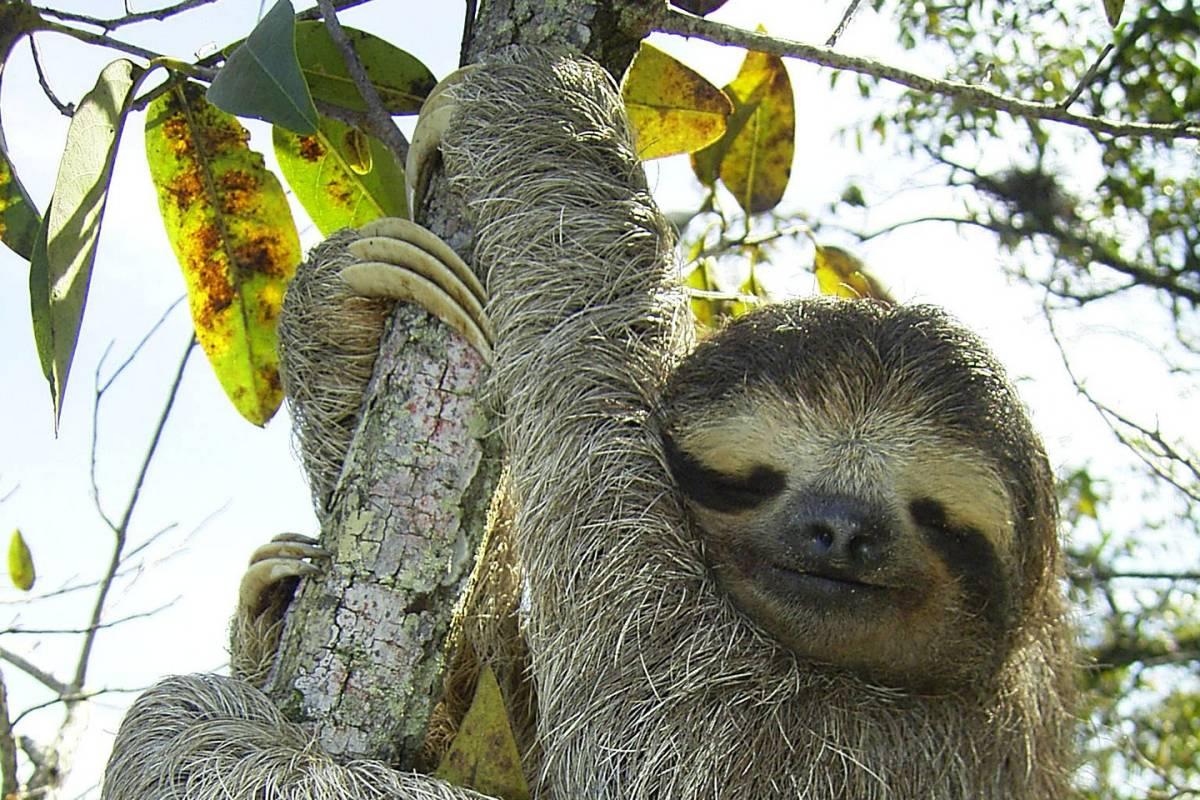
- Name: Pygmy three-toed sloth
- Scientific name: Bradypus pygmaeus
- Conservation status:
The pygmy three-toed sloth, also known as the dwarf sloth or the monk sloth, is a small species of sloth endemic to the island of Escudo de Veraguas, off the coast of mainland Panama, in the Caribbean Sea. It is on the brink of extinction, and there are fewer than 80 individuals left, which is why this species has been added to the list of the world’s 100 most threatened species.
The island as a whole is only 4.3 km² / 1.7 sq mi wide, and this sloth can only be found in the red mangroves.
4. Giant anteater
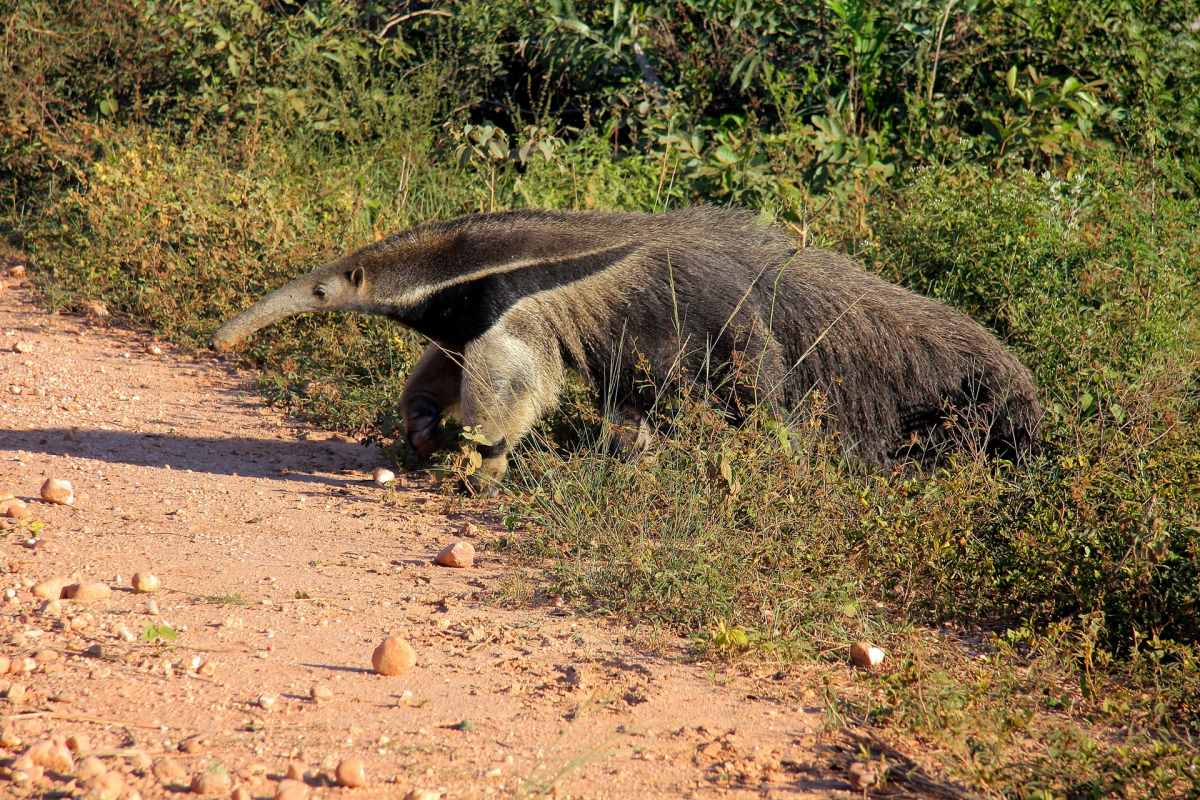
- Name: Giant anteater
- Scientific name: Myrmecophaga tridactyla
- Conservation status:
The giant anteater is a species of mammal native to Central and South America. It is primarily terrestrial, contrary to many other anteaters and sloths (to which it is related), and it can reach weights of up to 50 kg / 110 lb and lengths of up to 217 cm / 7 ft 1 in.
This anteater arrived in Central America from South America through Panama, 3 million years ago. This phenomenon is known as the Great American Interchange.
5. Panamanian white-faced capuchin
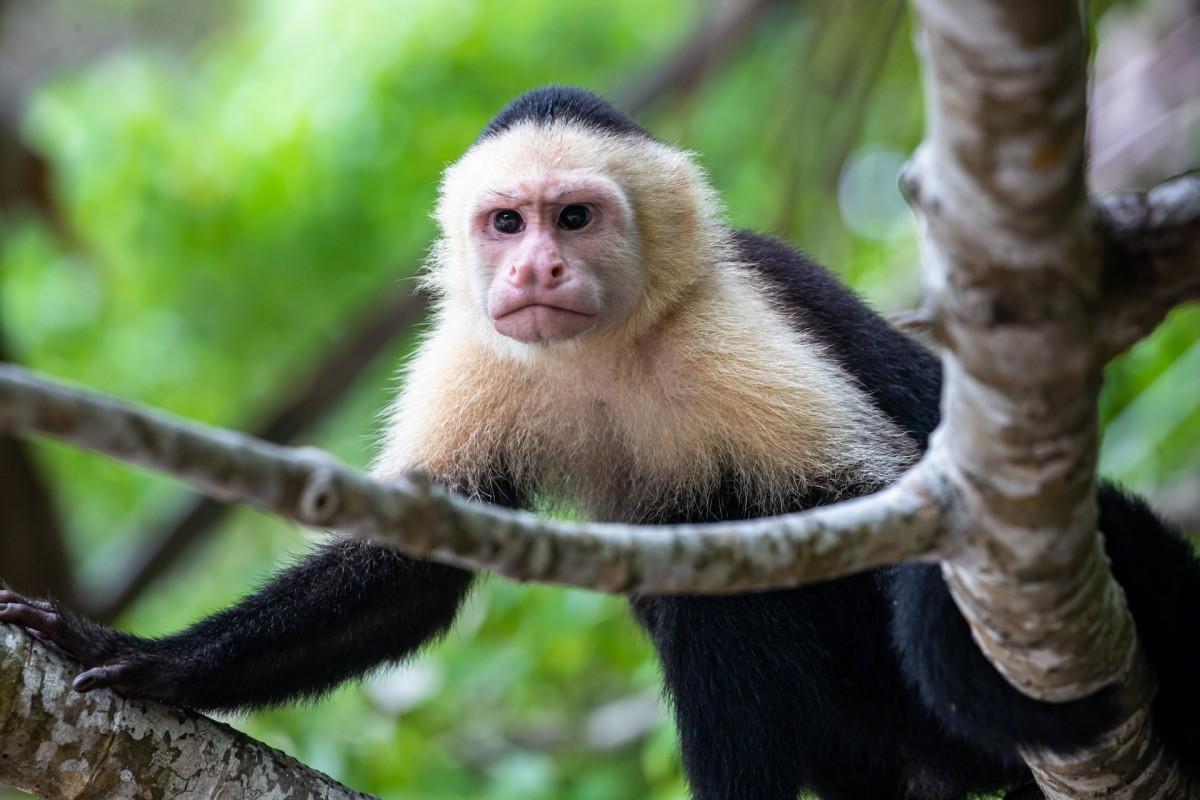
- Name: Panamanian white-faced capuchin
- Scientific name: Cebus imitator
- Conservation status:
The Panamanian white-faced capuchin, also known as the Panamanian white-headed capuchin or the Central American white-faced capuchin, is a species of New World monkey native to Panama, but also the rest of Central America. Because of its role in seed dispersing and pollination, it is particularly important to the rainforests’ ecology.
This monkey is highly social and lives in groups of about 16 individuals. Together, they primarily feed on fruit, only eating the juice and pulp and spitting out the seeds and fibers.
6. Dice’s cottontail
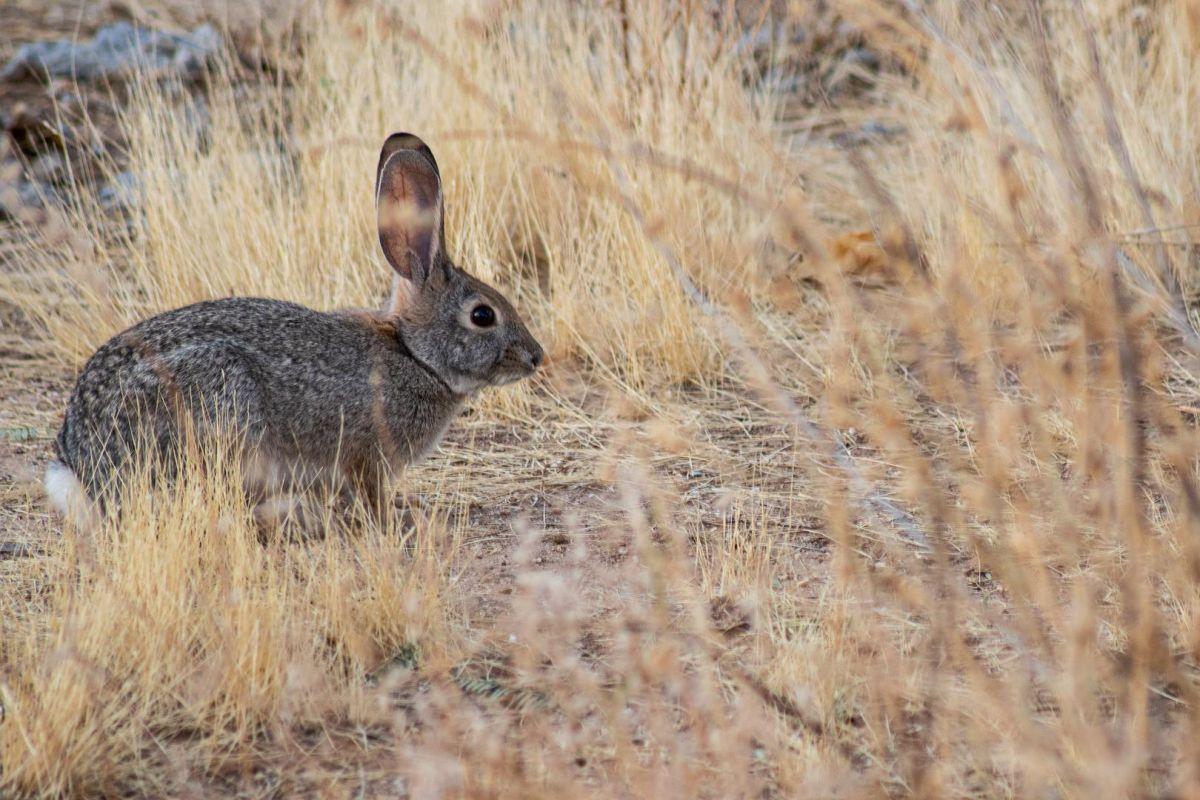
- Name: Dice’s cottontail
- Scientific name: Sylvilagus dicei
- Conservation status:
Dice’s cottontail is a species of cottontail rabbit native to a small area, from Costa Rica to Panama. It inhabits cloud forests, alpine meadows, and grasslands, and is one of the larger species of cottontail rabbits.
This rabbit has to face several threats, from natural predators such as coyotes to deforestation, wildfire, and agricultural expansion. Thankfully, it lives in a national park and should be protected from logging and other environmental damage.
7. Baird’s tapir
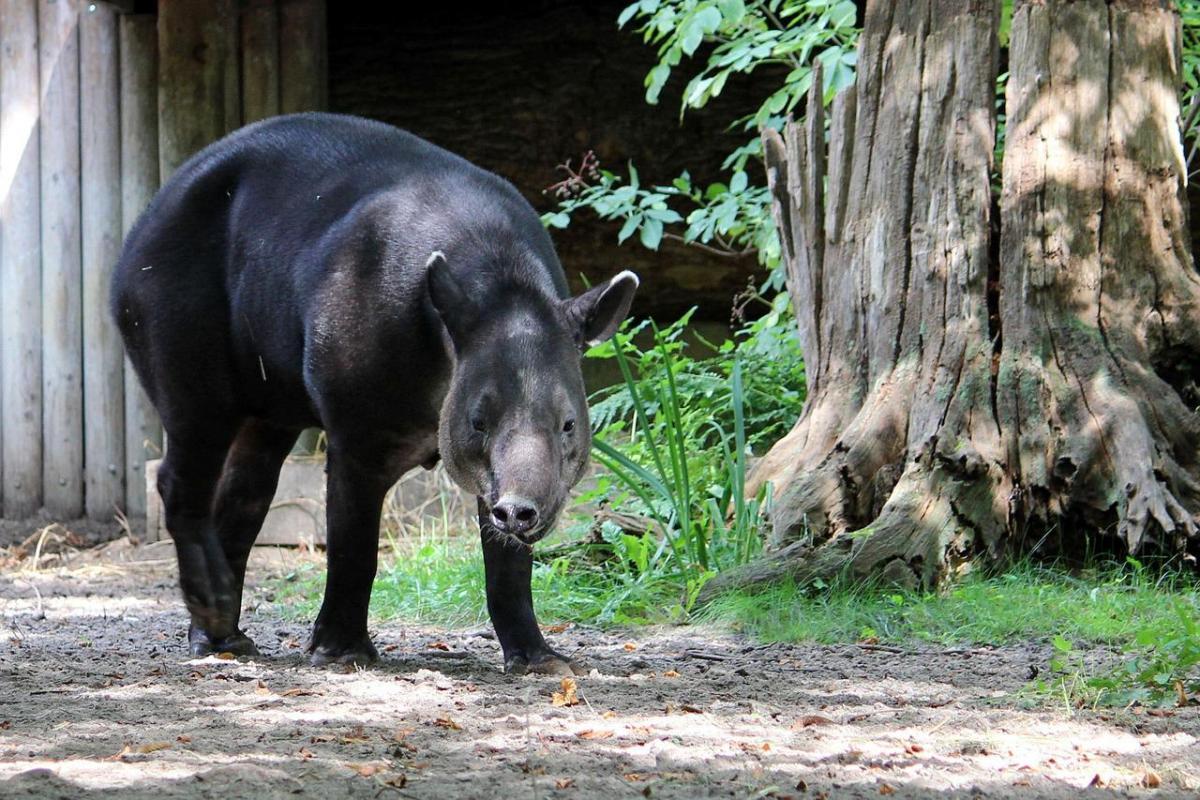
- Name: Baird’s tapir
- Scientific name: Tapirus bairdii
- Conservation status:
The Baird’s tapir, also known as the Central American tapir, is the largest native land mammal in Central and South America. It is native to Mexico, Central America, and northwestern South America, and inhabits many different areas such as wet tropical rainforests, marshes, and mangrove forests, usually from sea level to 3,600 m / 11,811 ft.
In Panama, it is illegal to hunt Baird’s tapir, but law enforcement is scarce.
8. Jaguar
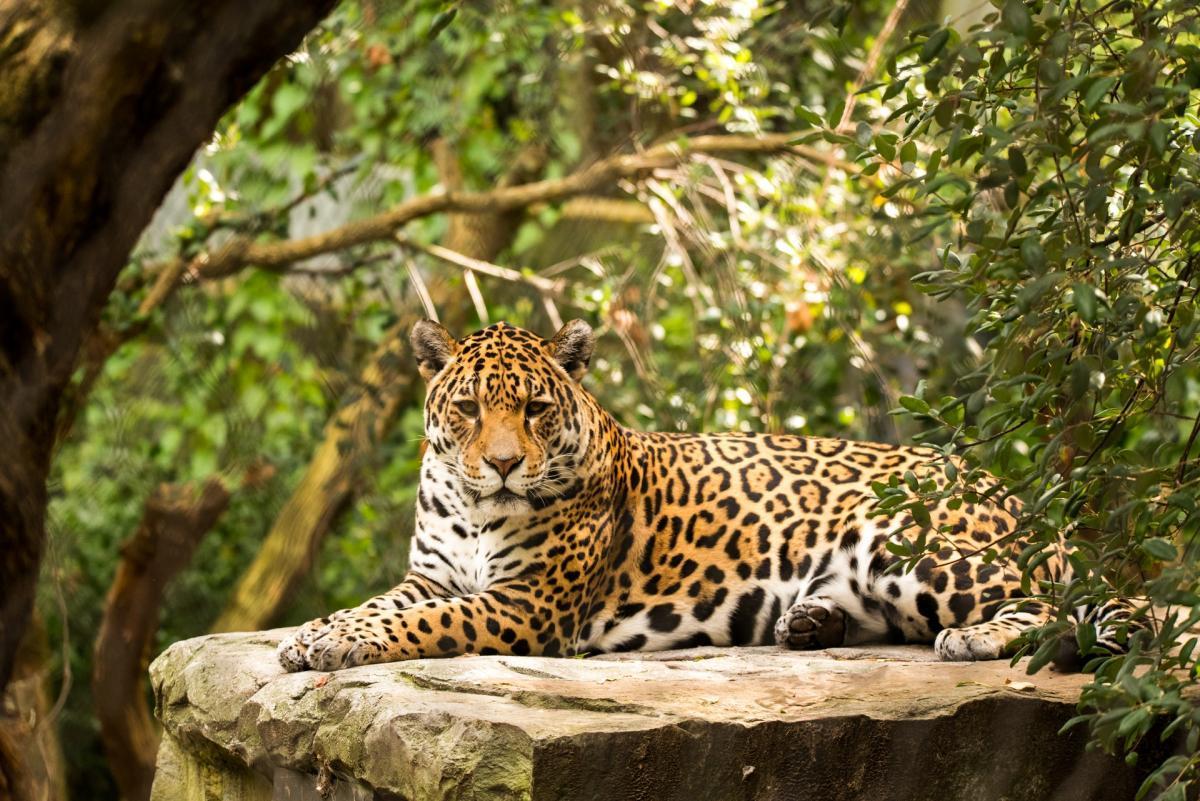
- Name: Jaguar
- Scientific name: Panthera onca
- Conservation status:
I bet you were waiting for this. The jaguar is definitely the most emblematic and well-known animal in all of South America. It is the largest species of wild cat in the Americas and the third-largest in the world.
Some rare individuals are melanistic, and therefore black; they are then known as black panthers, and some of them have been spotted in the eastern parts of Panama. The main threat of the jaguar in Panama is killing in retaliation for predation on livestock: 220 individuals have been killed this way between 1998 and 2014.
9. Coyote
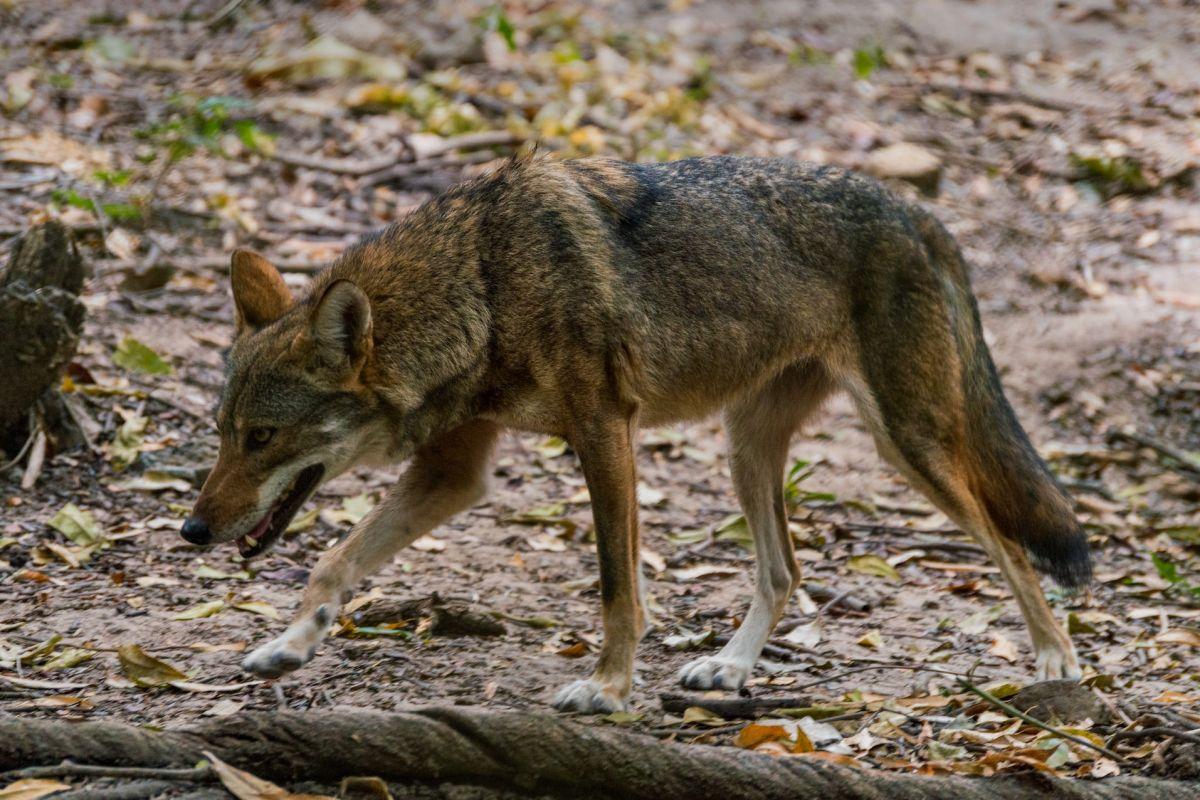
- Name: Coyote
- Scientific name: Canis latrans
- Conservation status:
The coyote, historically known as the bush wolf or the prairie wolf, is a species of canid native to North America, and can now be found further south, as far as Panama. It is a highly adaptable species, both in terms of diet and habitat. It is smaller than its close relative, the wolf.
In Panama, it was sighted across the Panama Canal from its home range in 2013, which means it is rapidly spreading.
10. Kinkajou
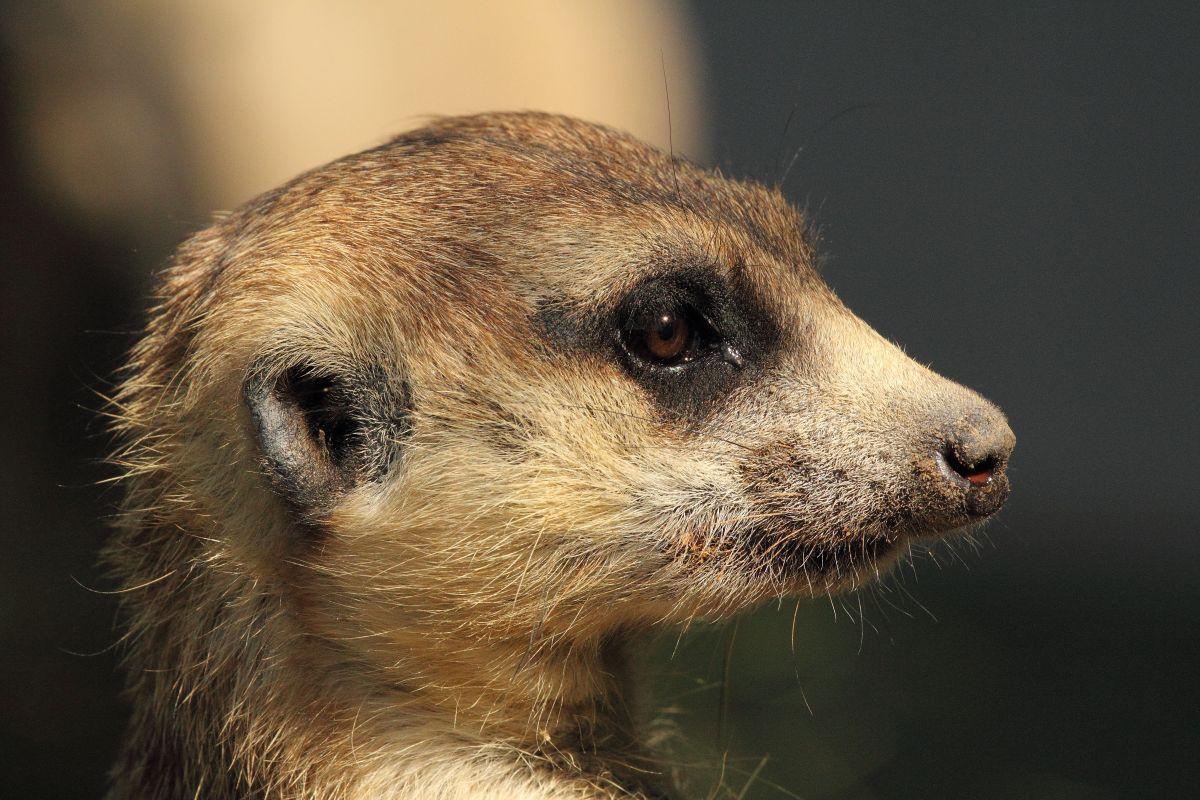
- Name: Kinkajou
- Scientific name: Potos flavus
- Conservation status:
The kinkajou is a species of tropical rainforest mammal native to Central and South America. It is related to raccoons, olingos, and coatis, and is sometimes called the honey bear.
This mammal is primarily frugivorous, and because of its alert nature and nocturnal behavior, it is rarely seen by people. Similar to the giant anteater, it arrived in Central America from South America through the Isthmus of Panama.
11. Oncilla
- Name: Oncilla
- Scientific name: Leopardus tigrinus
- Conservation status:
The oncilla, also known as the little spotted cat, the tigrillo or the northern tiger cat, is a small species of cat native to Central America and through to central Brazil. As its name suggests, it is a spotted cat.
This wild cat is seriously threatened by habitat conversion and loss, and its Panamanian population is disjunct from its main range, the northern half of South America. In the country, it has been seen in Volcán Barú and Darién national parks.
12. Crab-eating fox
- Name: Crab-eating fox
- Scientific name: Cerdocyon thous
- Conservation status:
The crab-eating fox, also known as the maikong, the bush dog, the wood fox, or the forest fox, is a medium-sized species of canid endemic to Central and South America. It inhabits savannas, woodlands, shrubby thickets, tropical savannas, and subtropical forests, and feeds on crabs, on muddy floodplains. Besides, it is important for the control of several harmful species of rodents and insects.
While it was probably there for a while, the crab-eating fox was not spotted in Panama until the 1990s.
13. Central American red brocket
- Name: Central American red brocket
- Scientific name: Mazama temama
- Conservation status:
The Central American red brocket is a species of brocket deer native to Mexico, Central America and northwestern Colombia. After being treated as a subspecies of the red brocket, which lives in South America, it has been classified as a separate species, and its numbers have not been assessed yet, which is why it is listed as data deficient.
This deer lives in secondary tropical forests, at elevations ranging from sea level to 2,800 m / 9,186 ft.
14. Collared peccary
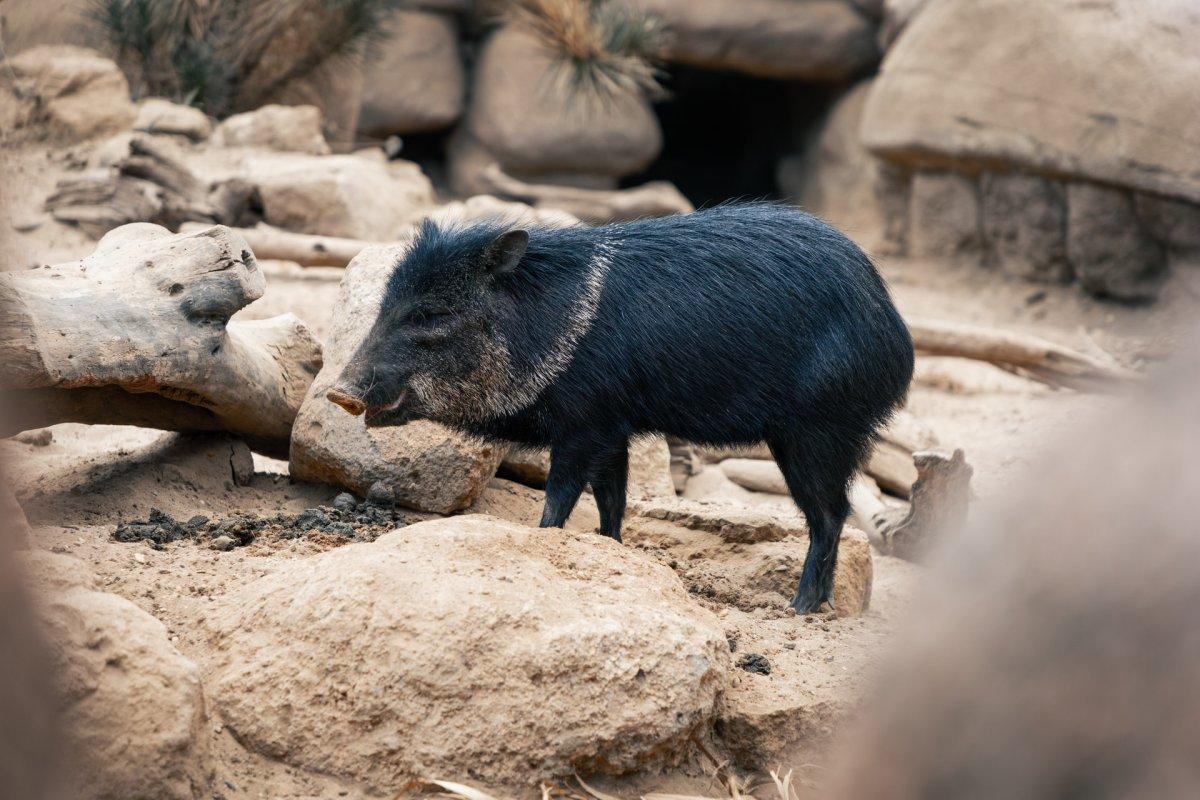
- Name: Collared peccary
- Scientific name: Dicotyles tajacu
- Conservation status:
The collared peccary, also known as the musk hog or the javelina, is a species of mammal native to northern, central, and southern America. Classified as a herbivore, it feeds on cactus, fruits, beans, berries, roots, palm nuts, fungi, and grasses.
This mammal is active by day and lives in large groups of up to 50 individuals. Although it usually ignores humans, it will not hesitate to defend itself with its tusks if threatened, and some Amazonian peoples have already tamed collared peccaries.
15. Ocelot
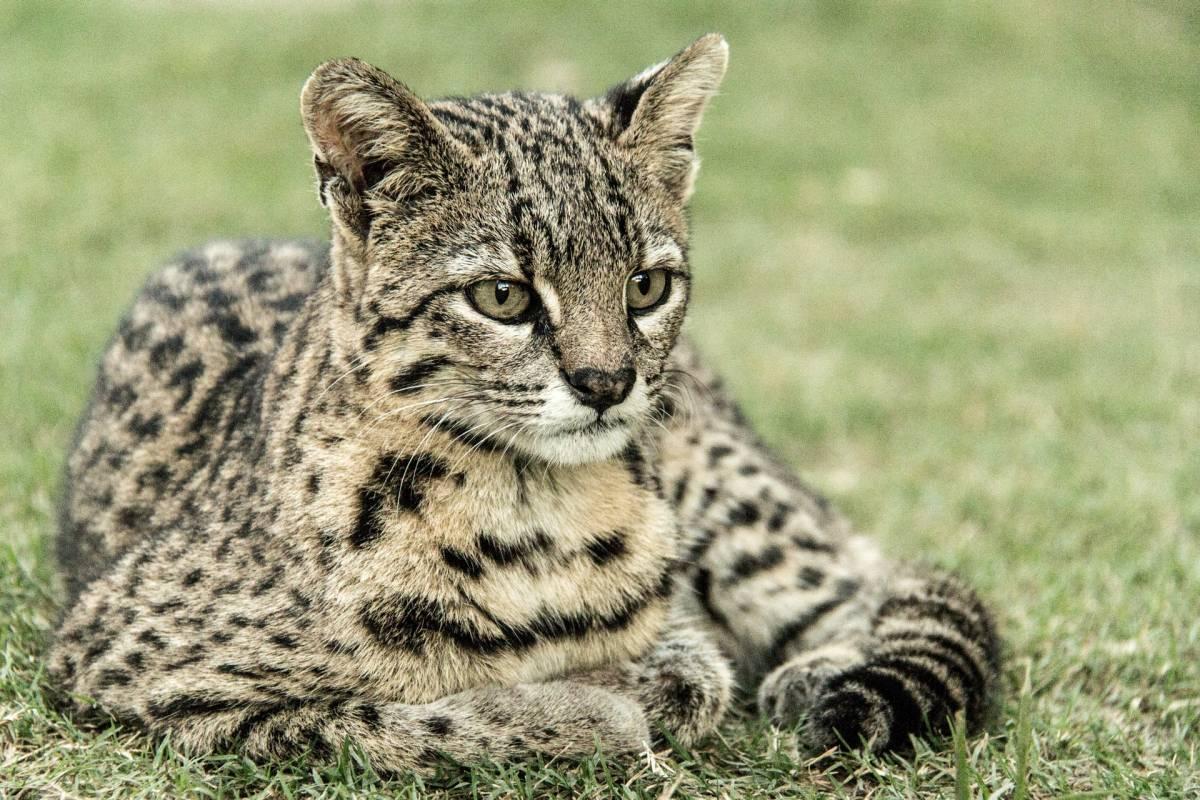
- Name: Ocelot
- Scientific name: Leopardus pardalis
- Conservation status:
The ocelot is a medium-sized species of wild cat native to much of the Americas, from the southern United States to northern Argentina. It inhabits areas with dense vegetation, high prey availability and ideally a body of water. Interestingly enough, it has been associated with humans for millennia, being depicted in Aztec and Incan art. Besides, Salvador Dalí had his own pet ocelot, Babou!
In Panama, it is forbidden to hunt the ocelot, while it is regulated in countries such as Peru. There are about 40,000 mature individuals in the world.
16. Bush dog
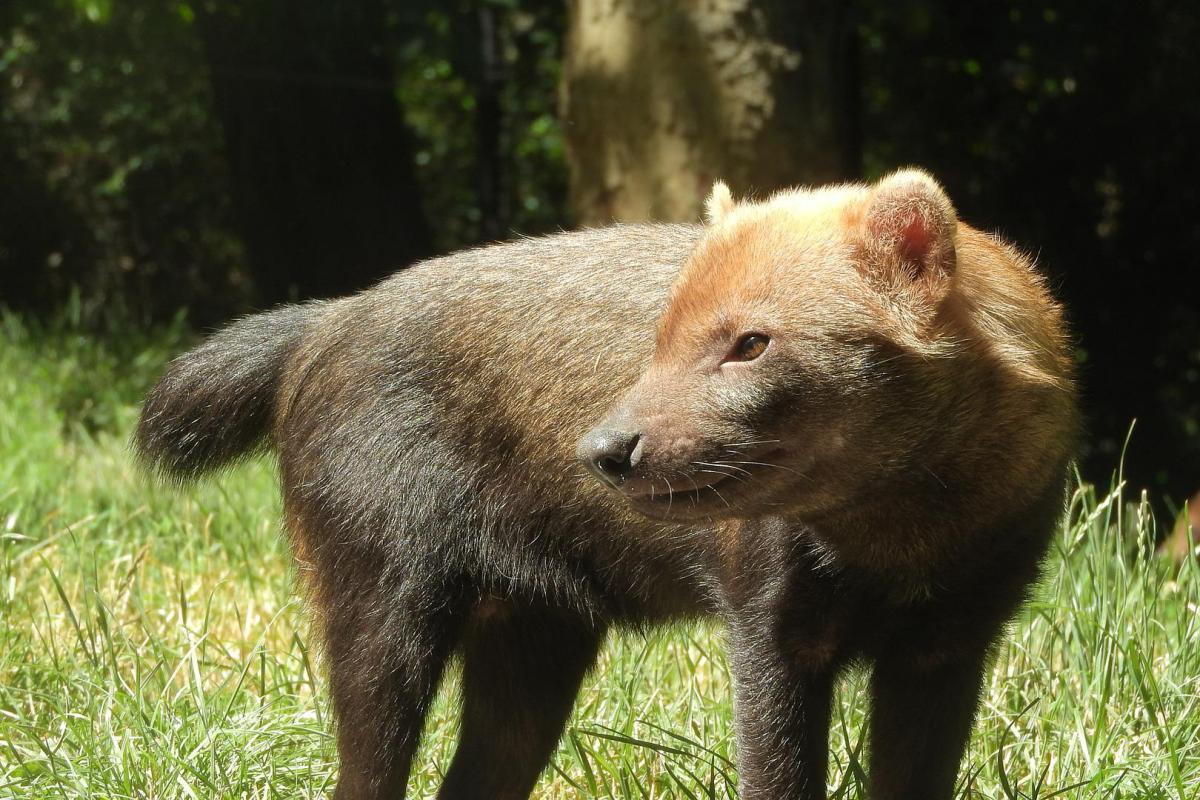
- Name: Bush dog
- Scientific name: Speothos venaticus
- Conservation status:
The bush dog, not to be confused with the bush dog, one of the names of the crab-eating fox, is a species of canine native to Central and South America. Despite having a very wide range, it is rarely seen and is very rare in most areas within its range; because of this, it has been listed as near threatened with extinction.
In Panama, the local subpopulation is known as the Panamanian bush dog, and it can also be found in northern Colombia and Venezuela, and western Ecuador.
17. Cacomistle
- Name: Cacomistle
- Scientific name: Bassariscus sumichrasti
- Conservation status:
The cacomistle is a species of arboreal carnivore native to Central America. It inhabits tropical forests, wet forests, mountain forests, and evergreen woodlands, and is primarily threatened by deforestation, although not substantially. It is a solitary animal that has a very wide home range of at least 20 hectares, or 20 sports fields!
This mammal is a generalist feeder that can subsist on a variety of different food sources, such as insects, fruits, and small vertebrates such as rodents, reptiles, and amphibians.
18. White-nosed coati
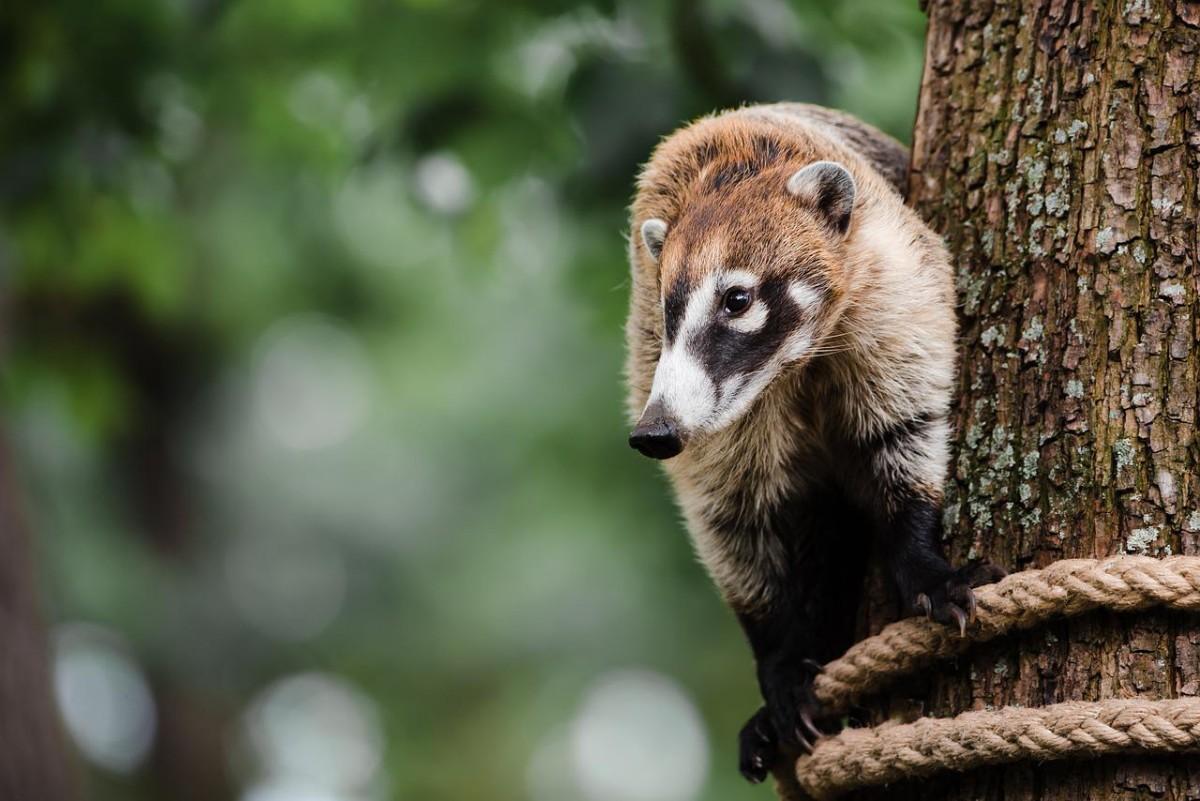
- Name: White-nosed coati
- Scientific name: Nasua narica
- Conservation status:
The white-nosed coati, also known as the coatimundi, is a species of coati native to Central America and as far north as the southwestern United States. Its tail, which is particularly useful for balancing, is about the same size as its body, and it is an omnivorous, arboreal animal that feeds on small vertebrates, snakes, insects, fruits, eggs, and carrion.
This coati has an important interaction with the balsa tree, which provides a critical source of hydration during hard times, while the coati pollinates and spreads the tree in return.
19. Margay
- Name: Margay
- Scientific name: Leopardus wiedii
- Conservation status:
The margay is yet another species of wild cat found in Panama. Native to Central and South America, it is both nocturnal and solitary and inhabits the deciduous and primary evergreen forests of the country.
This felid has been hunted illegally for the wildlife trade until the 1990s, after which law enforcement came into play. Because of this and habitat loss due to deforestation, the margay’s population is globally on the decline, and this species is considered near threatened with extinction.
20. Cuvier’s beaked whale
- Name: Cuvier’s beaked whale
- Scientific name: Ziphius cavirostris
- Conservation status:
Not only is Panama’s terrestrial wildlife incredible, but the coastal and off-shore areas of the country are filled with exotic wonders, such as Cuvier’s beaked whale.
Also known as the goose-beaked whale, Cuvier’s beaked whale is smaller than most baleen whales, and is a fantastic diver: while it usually lives at about 300 m / 1,000 ft below sea level, it has the deepest and longest recorded dives of all whales, at 2,992 m / 9,816 ft and 222 minutes / 3.7 hours respectively!
21. Cougar
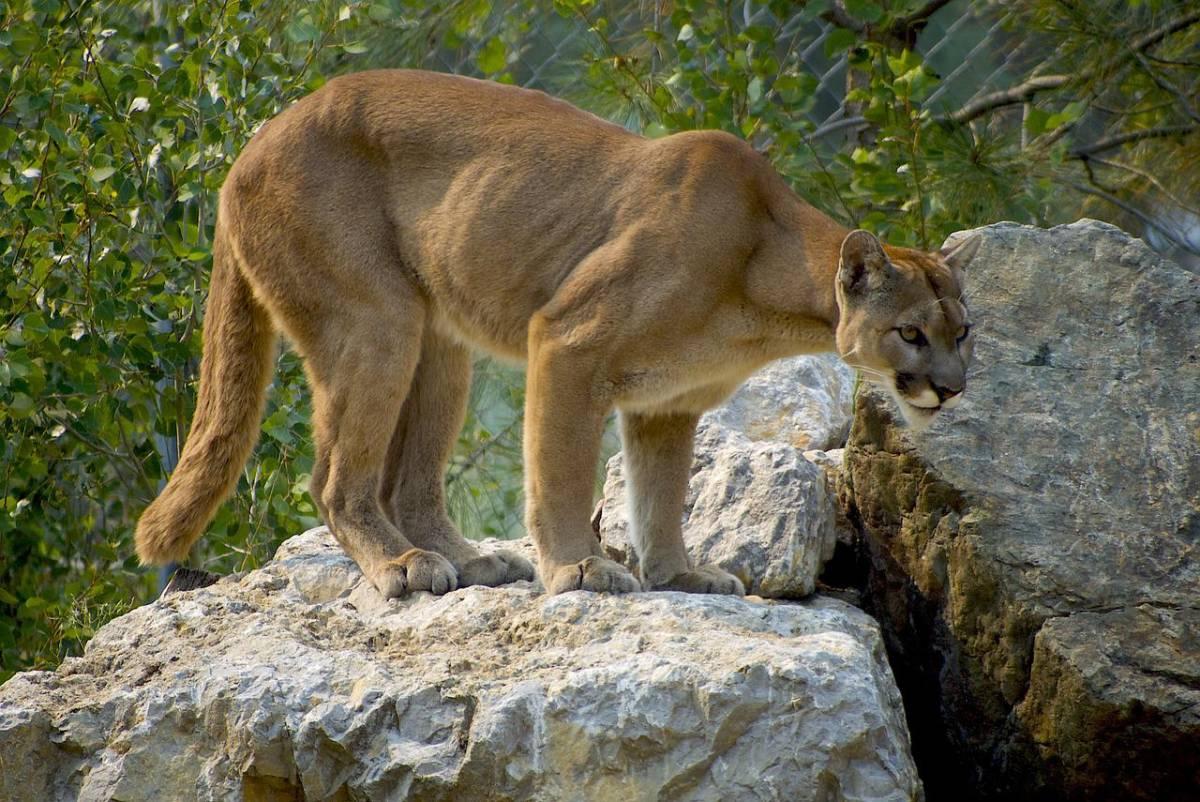
- Name: Cougar
- Scientific name: Puma concolor
- Conservation status:
The cougar, also known as the mountain lion, the panther, the puma, and the catamount, is the other species of big cat you will find in Panama. It is the most widespread of any large terrestrial mammal in the Western Hemisphere, and it can be found all around the Americas, usually in rocky areas and woodlands.
It is forbidden to hunt cougar in several countries and territories, including Panama.
22. Jaguarundi
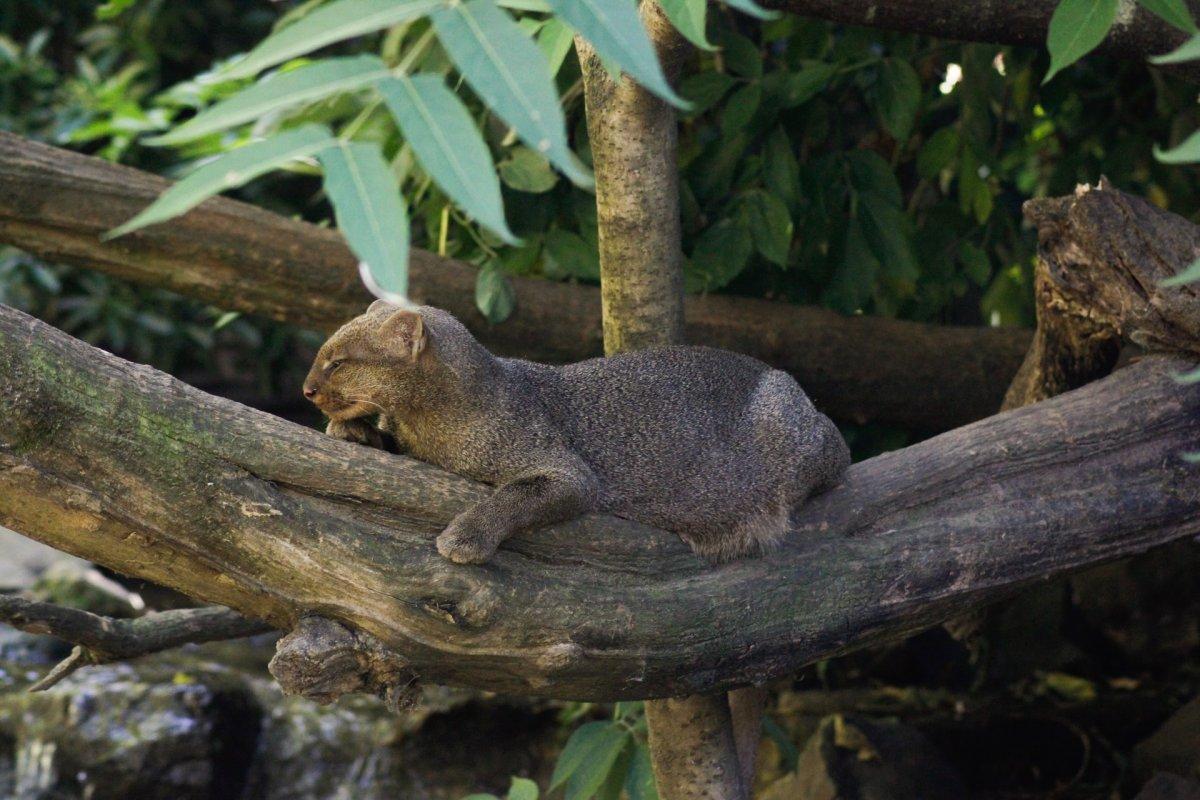
- Name: Jaguarundi
- Scientific name: Herpailurus yagouaroundi
- Conservation status:
I swear, this is the last species of wild cat that I will talk about in this list, but they are simply too interesting and, let’s be honest, beautiful.
The jaguarundi is a species of wild cat native to much of the Americas, from central Argentina to northern Mexico. Its hunting is restricted in Panama, and because of its highly secretive and alert nature, it is seldom seen by humans.
23. Northern olingo
- Name: Northern olingo
- Scientific name: Bassaricyon gabbii
- Conservation status:
The northern olingo, also known as the bushy-tailed olingo or simply the olingo, is a species of tree-dwelling mammal native to a somewhat small area of Central America, which includes Panama, Costa Rica, Nicaragua, Guatemala, and Honduras. It inhabits tropical moist forests and montane forests, at elevations between 1,000 and 2,000 m / 3,300 and 6,600 ft.
This olingo is a nocturnal herbivore, and it almost exclusively feeds on fruits, primarily figs.
24. Crab-eating raccoon
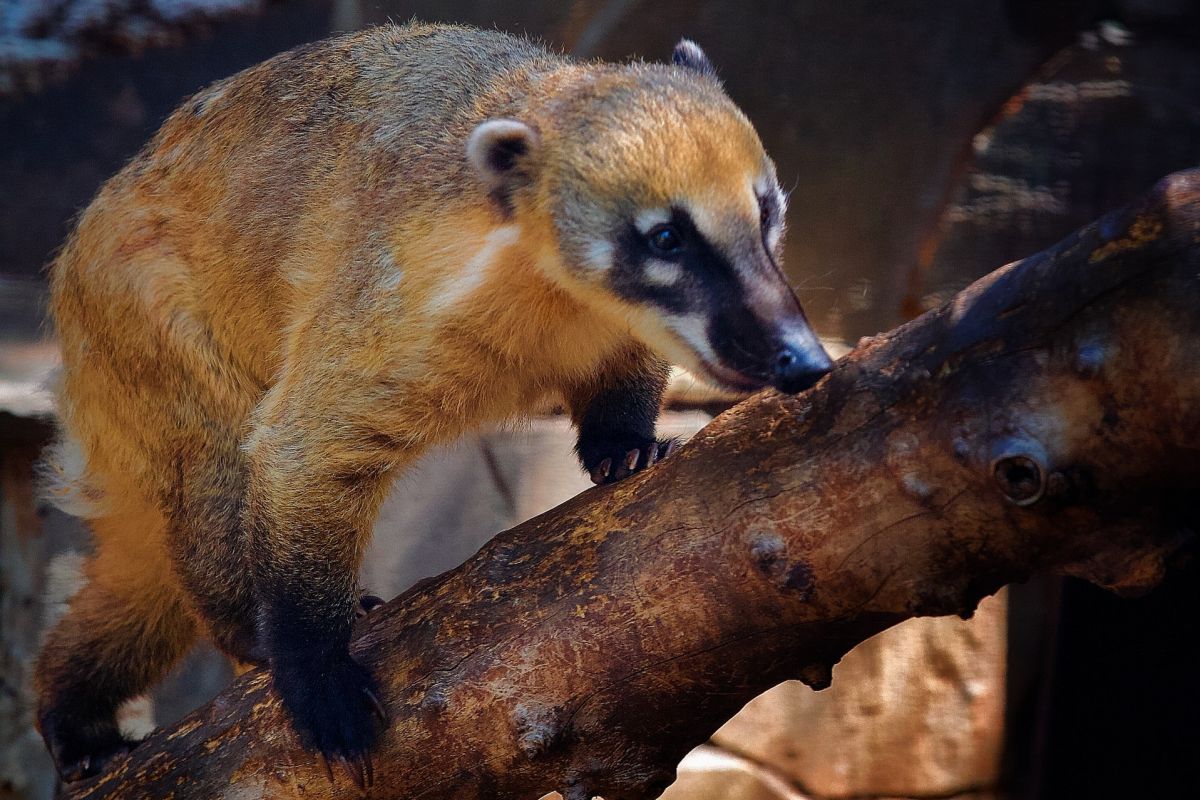
- Name: Crab-eating raccoon
- Scientific name: Procyon cancrivorus
- Conservation status:
It looks like crabs are having a hard time in Panama because after the crab-eating fox comes the crab-eating raccoon, also known as the South American raccoon.
This mammal definitely feeds on crabs but complements its diet with crayfish, lobster, and other shellfish and crustaceans. It spends a significant amount of time in trees but is primarily terrestrial. The crab-eating raccoon usually lives near rivers, lakes, and streams, and only in inland streams and rivers in Panama.
25. Tayra
- Name: Tayra
- Scientific name: Eira barbara
- Conservation status:
The tayra is a species of mammal native to Central and South America. It has a long, slender body and looks like a weasel or a marten. About 7 subspecies of the tayra are recognized, and the one found in Panama is called Eira barbara sinuensis; it also lives in northern Ecuador and western Venezuela.
This mammal is active by day, and although assumed solitary, it has been seen in larger groups.
26. Greater grison
- Name: Greater grison
- Scientific name: Galictis vittata
- Conservation status:
The greater grison is a large species of mustelid native to Mexico, Central America, and the northern half of South America. It has short legs and a slender body and can be found at elevations between 500 and 2,000 m / 1,600 and 6,600 ft, depending on the area.
This mammal uses its anal scent glands to create a yellowish musk in order to mark its territory and spray at potential attackers.
27. Neotropical otter
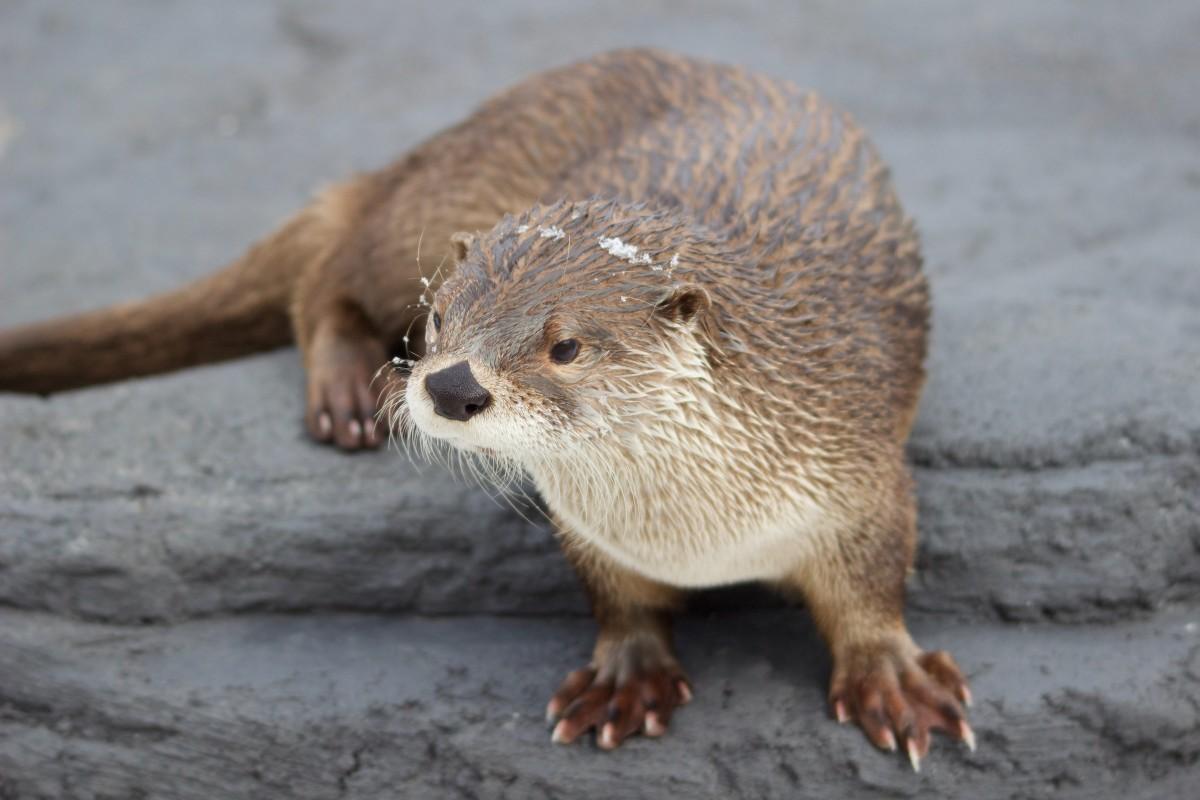
- Name: Neotropical otter
- Scientific name: Lontra longicaudis
- Conservation status:
The neotropical otter, also known as the neotropical river otter, is a species of otter native to Central and South America and introduced to the island of Trinidad. It inhabits riverine habitats in savannas, pantanal, llanos, and evergreen forests, and prefers fast-flowing streams and rivers.
This otter is solitary and primarily feeds on a wide variety of crustaceans and fish. Its pelage is short and dark, and males are about 25 percent larger than females.
28. Blue whale
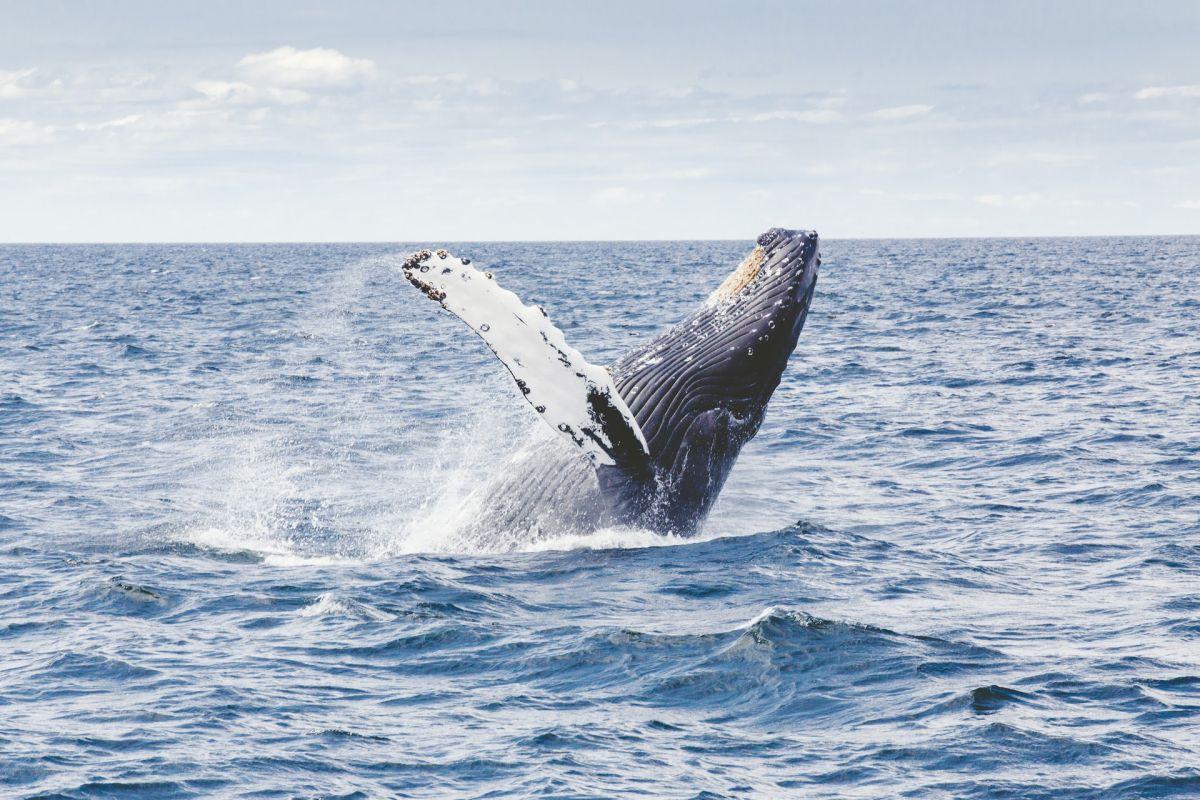
- Name: Blue whale
- Scientific name: Balaenoptera musculus
- Conservation status:
The blue whale is the largest animal known to have ever existed. Just that.
The blue whale can sometimes be spotted off the coasts of Panama, but it lives all around the world’s oceans and seas. Depending on the season, it either swims through arctic or subtropical and tropical waters. It used to be abundant in every ocean until the end of the 19th century and overhunting by whalers, which almost caused the species to completely disappear. Now, although protected, it faces serious threats such as pollution, ocean noise, climate change, and ship strikes.
29. Central American squirrel monkey
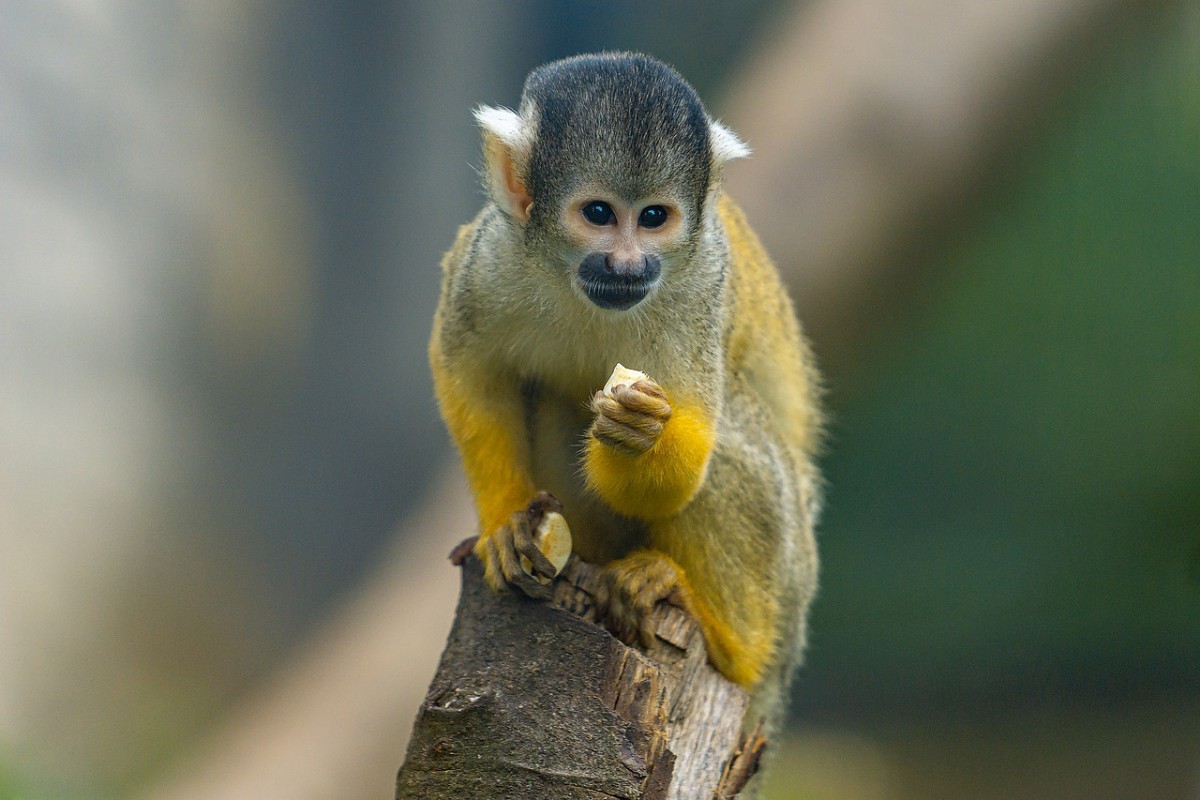
- Name: Central American squirrel monkey
- Scientific name: Saimiri oerstedii
- Conservation status:
The Central American squirrel monkey, also known as the red-backed squirrel monkey, is a species of squirrel monkey endemic to the Pacific coast of Panama and Costa Rica. It is quite small and has a unique black and white face mask with orange body parts, and is considered endangered because of its small range and hunting, capture to be kept as a pet, and habitat loss.
There are about 130 Central American squirrel monkeys per km² / 337 per sq mi in Panama, and their global population has gone from 200,000 in the 1970s to fewer than 5,000 now.
30. Harpy eagle
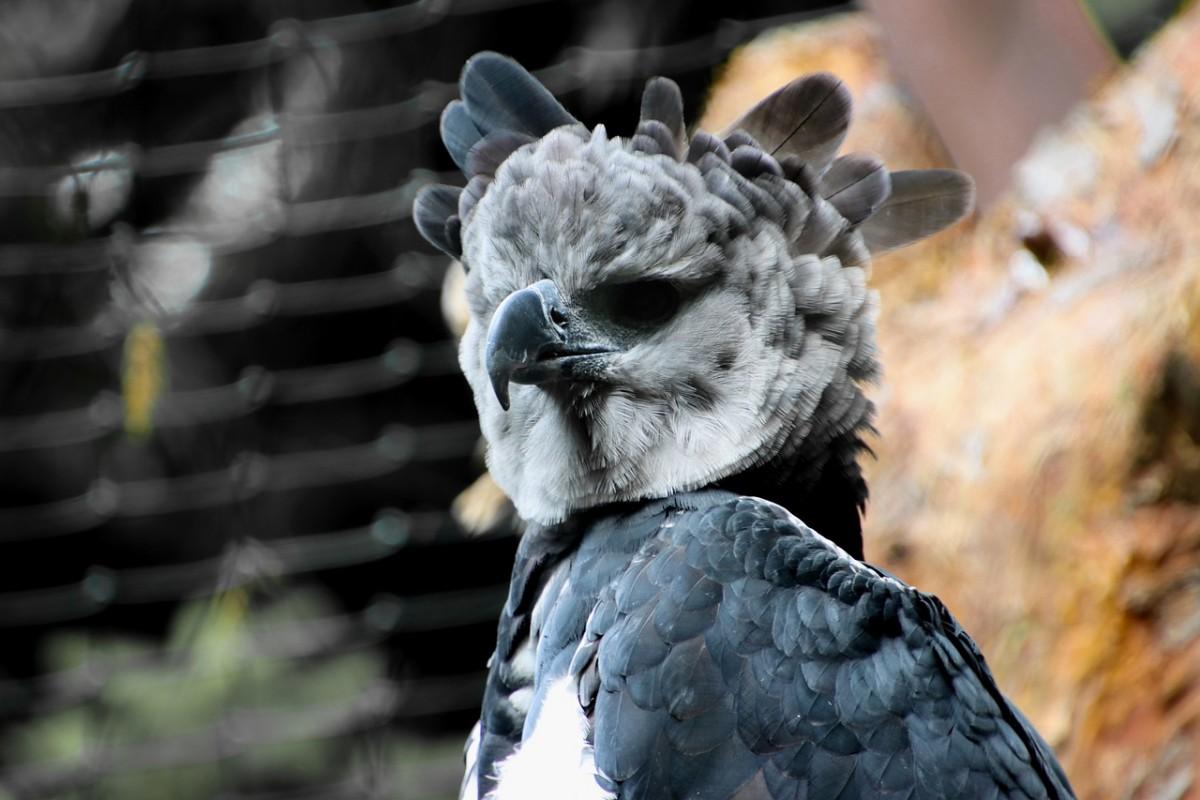
- Name: Harpy eagle
- Scientific name: Harpia harpyja
- Conservation status:
I know we cannot talk about every animal in Panama, but we have to keep some spots for birds, and what a bird that is.
The harpy eagle, also known as the American harpy eagle, is one of Panama’s national animals. It is particularly large and powerful, and inspired the phoenix Fawkes in the Harry Potter saga! This eagle can be found in Central and South America and is pretty rare within its range.
31. Keel-billed toucan
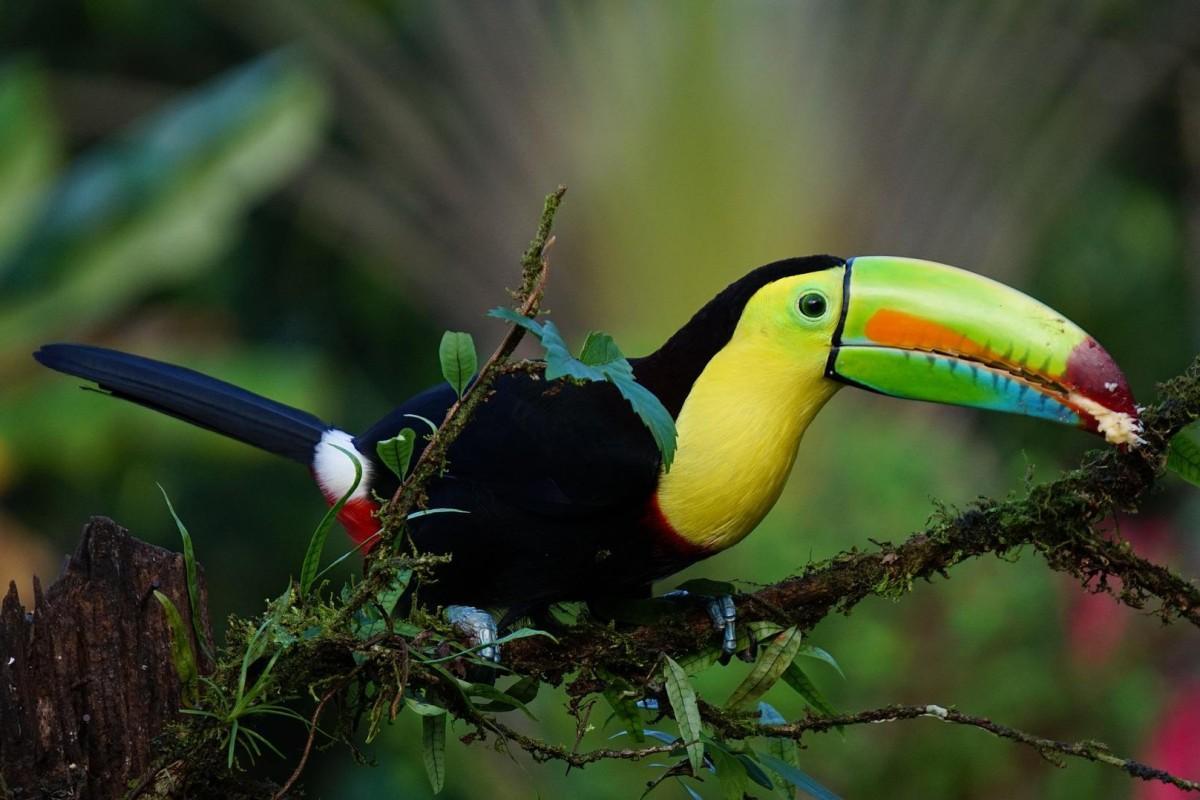
- Name: Keel-billed toucan
- Scientific name: Ramphastos sulfuratus
- Conservation status:
Toucan as a whole is one of the most iconic birds of Central and South America. Toucans are often very colorful and are characterized by their unique, large bill.
The keel-billed toucan, also known as the rainbow-billed toucan or the sulfur-breasted toucan, is one of the most colorful species of toucans. It can be found in the tropical jungles from Mexico to Colombia and feeds on fruits, insects, snakes, and small birds.
32. Black vulture
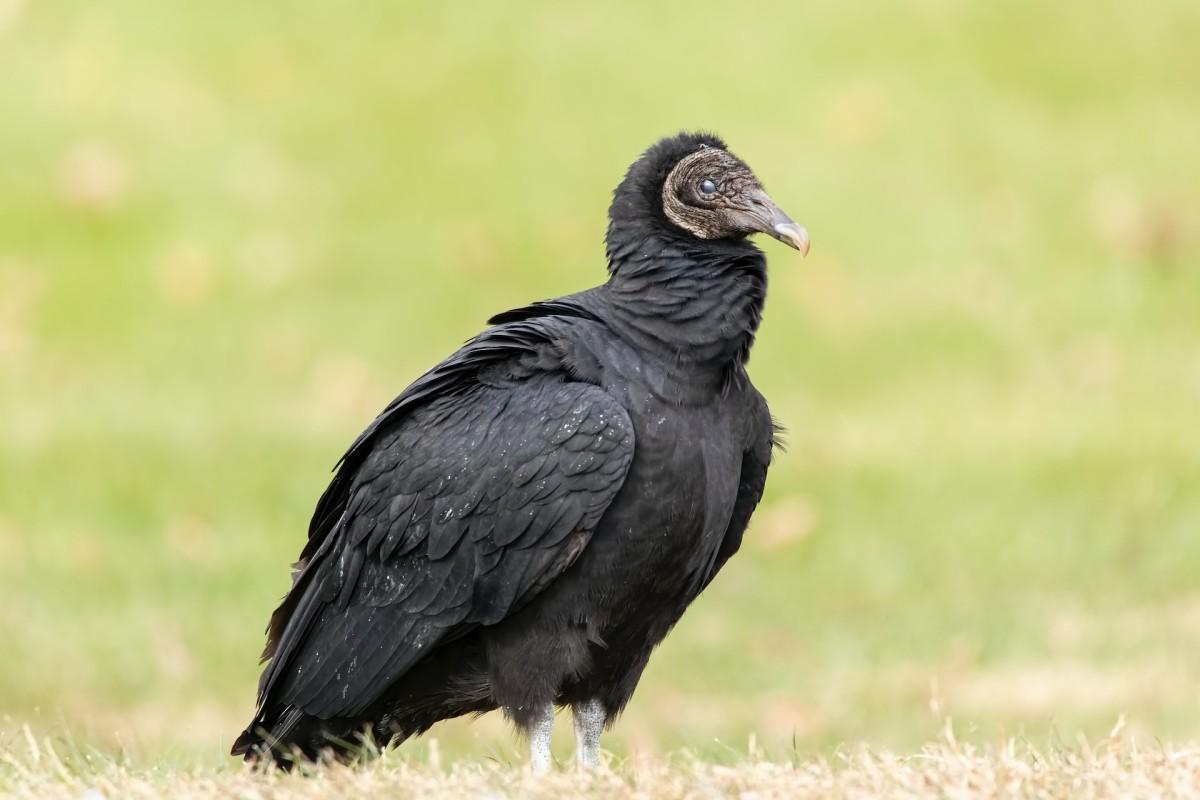
- Name: Black vulture
- Scientific name: Coragyps atratus
- Conservation status:
Much less colorful and cheerful, the black vulture, also known as the American black vulture, is a species of New World vulture found in much of the Americas, from the southern United States to Chile, Uruguay, and Argentina.
In Panama, the black vulture is very common in cities and towns. It is a scavenger that feeds on carrion in wild areas, garbage dumps, rotten fruits, decomposing plant matter, and fish in human areas.
33. Scarlet macaw
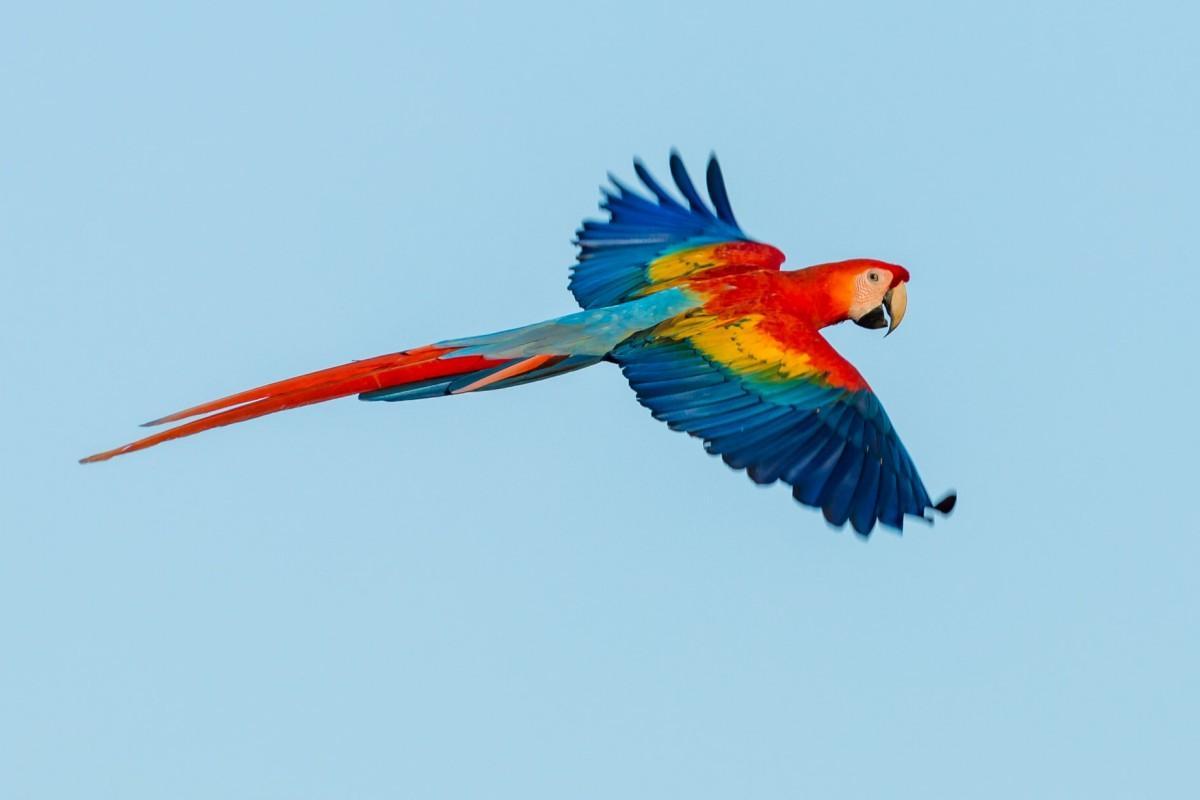
- Name: Scarlet macaw
- Scientific name: Ara macao
- Conservation status:
What would my list look like if I did not include such a marvelous animal as the scarlet macaw?
Pretty rare in Panama, it can mostly be found on Coiba Island. Historically, it has been one of the first examples of parrot breeding in captivity.
This macaw lives in humid evergreen forests, at elevations between 500 and 1,000 m / 1,600 and 3,300 ft, and has suffered local extinction in several areas, primarily because of habitat loss.
—
So there you have them, these were my 33 Panama native animals. I hope you enjoyed this list and that you learned something new today.
In case you want to learn more about the animals that live in Panama, feel free to keep reading, as I still have lots of things to tell you about:
Endangered Animals of Panama
This is definitely the saddest part of the list, but it is very important to raise awareness. Because of this, let’s go through the list of endangered animals in Panama.
Here are the animals in danger of extinction in Panama.
- Chiriqui harlequin frog
- Splendid poison frog
- Variable harlequin frog
- Chucanti salamander
- Hawksbill turtle
- Tabasara rain frog
- Pygmy three-toed sloth
- and 52 more…
- Vicente’s poison frog
- Horned marsupial frog
- Cerro Pando salamander
- Black-crowned Central American squirrel monkey
- Pacific nurse shark
- and 89 more…
To see the full list of endangered species in Panama, head over to the International Union for Conservation of Nature’s Red List.
What is the National Animal of Panama?
The national animal of Panama is the harpy eagle… and the Panamanian golden frog. Because yes, Panama has 2 national animals!
First off, the harpy eagle, also known as the American harpy eagle, is a neotropical species of eagle native to Central and South America. It is the most powerful raptor within its range, and one of the largest eagles in the world. It is depicted on the coat of arms of Panama.
Secondly, the Panamanian golden frog is also a national symbol, being represented in local mythology and state lottery tickets. It is said to turn to gold when dying and bring good luck to anyone seeing it. It even has its own national day, on August 14th!
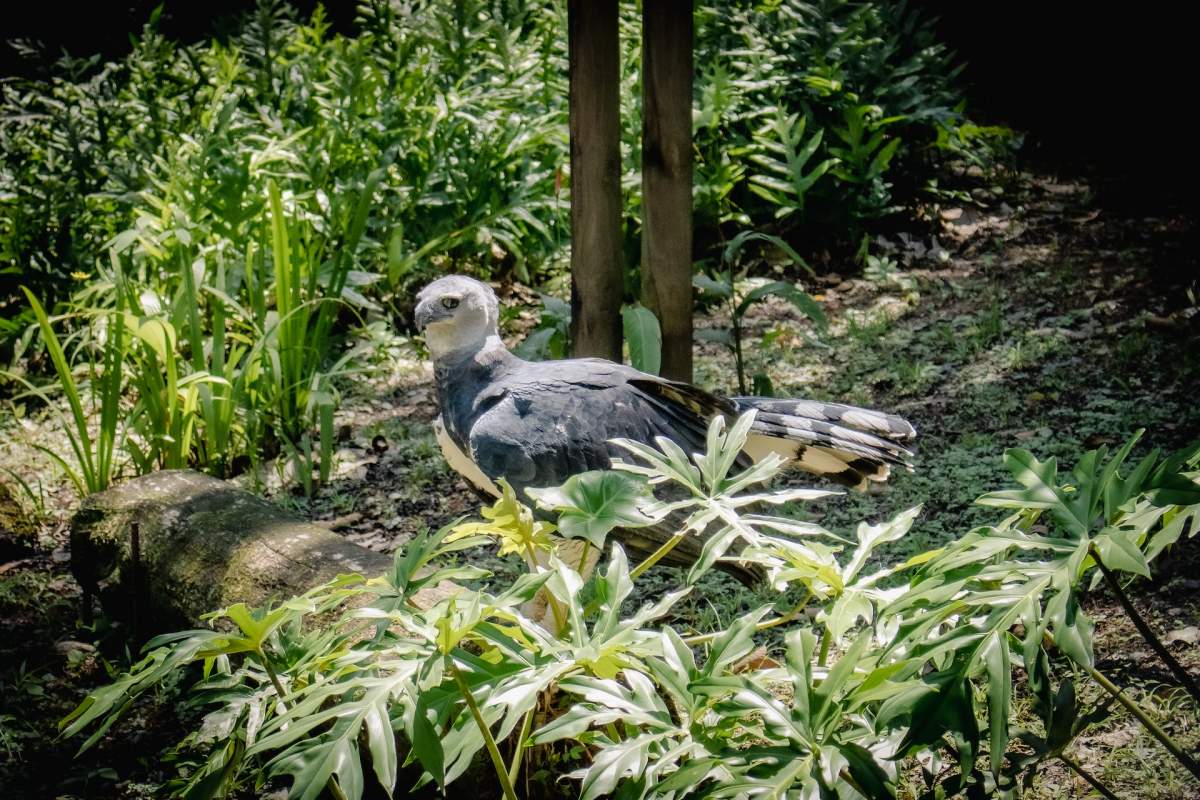
How Many Animals Native to Panama?
What is the diversity of native animals in Panama?
Let’s look at the total number of species of Chordata (mammals, birds, fishes, and reptiles).
Total number of animal species in Panama: 3,971 (8,066 in total in Mesoamerica)
What animals are unique to Panama?
Panama and its unique wildlife are definitely full of surprises and marvels. It will not surprise you that a few species can only be found within the country, mainly birds.
Some of the endemic species to Panama are the snowy-bellied hummingbird, the violet-capped hummingbird, the crimson-backed tanager, the orange-crowned oriole, and the golden-fronted greenlet.
More About Animals in the World!
Loved these Panama wildlife facts? Want to see what animals live in other countries?
Then check out these posts:
Or click here to see ALL the facts up on the blog! Spoiler alert: there’s A LOT of them.
Share the knowledge! Click on the buttons below to share information about these famous animals in Panama with your friends, and help them learn more about the world 🙂
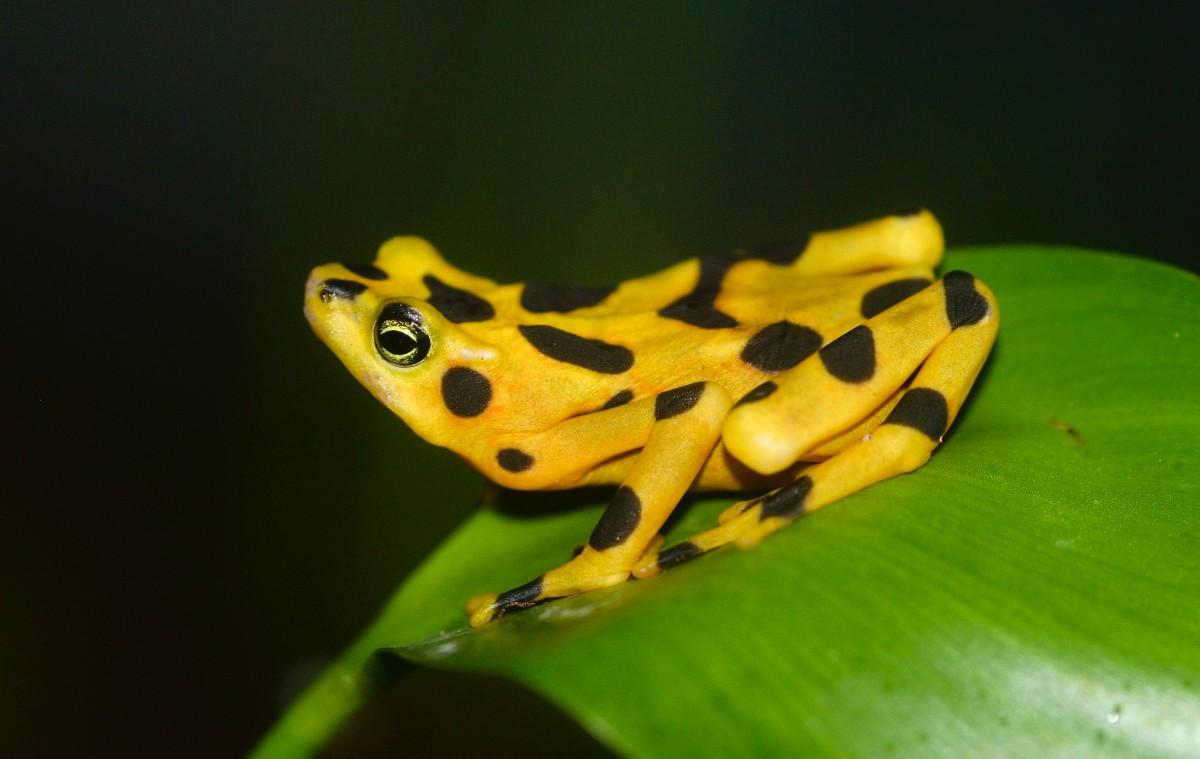
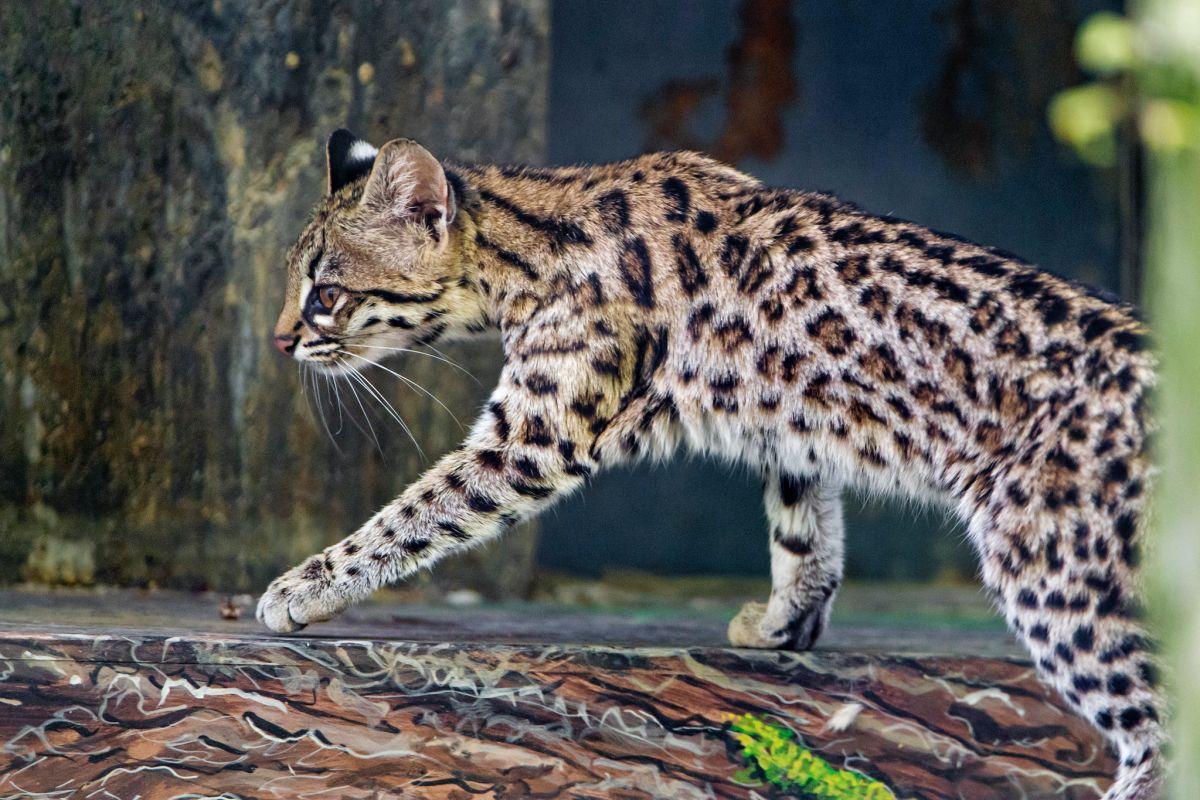
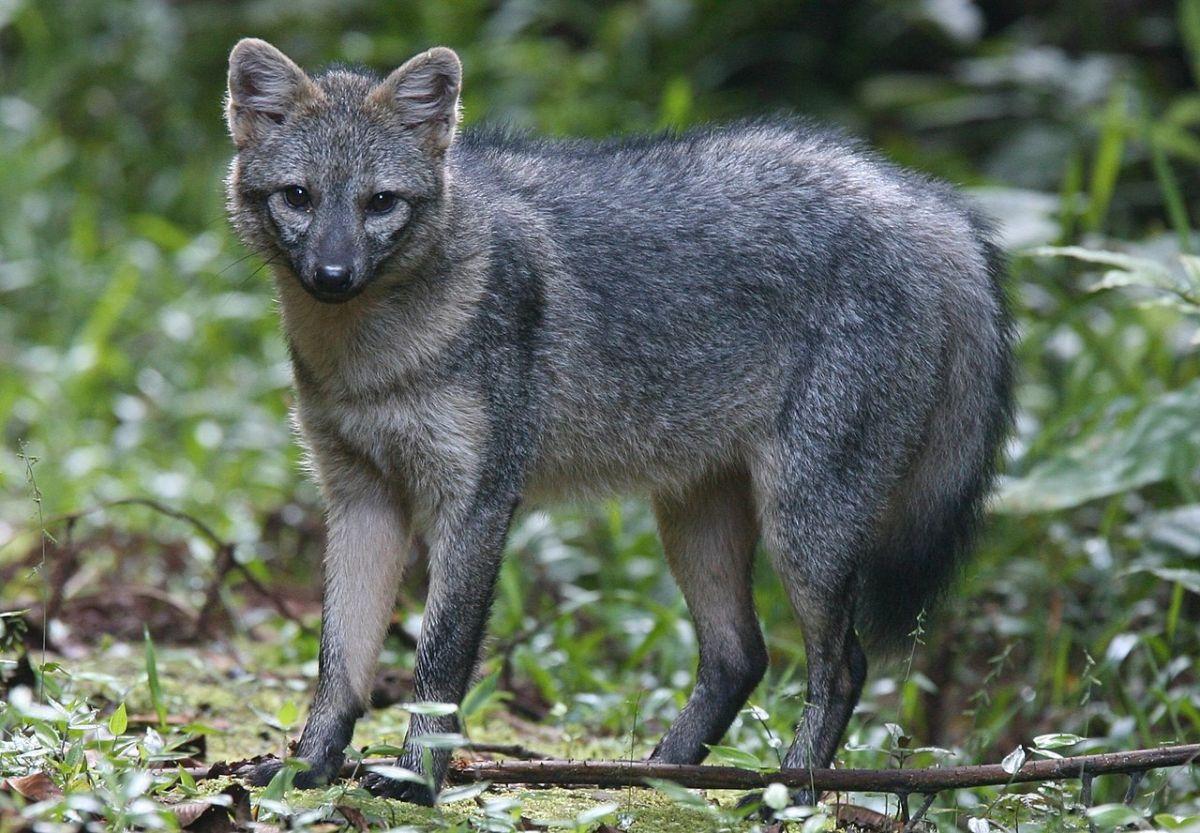
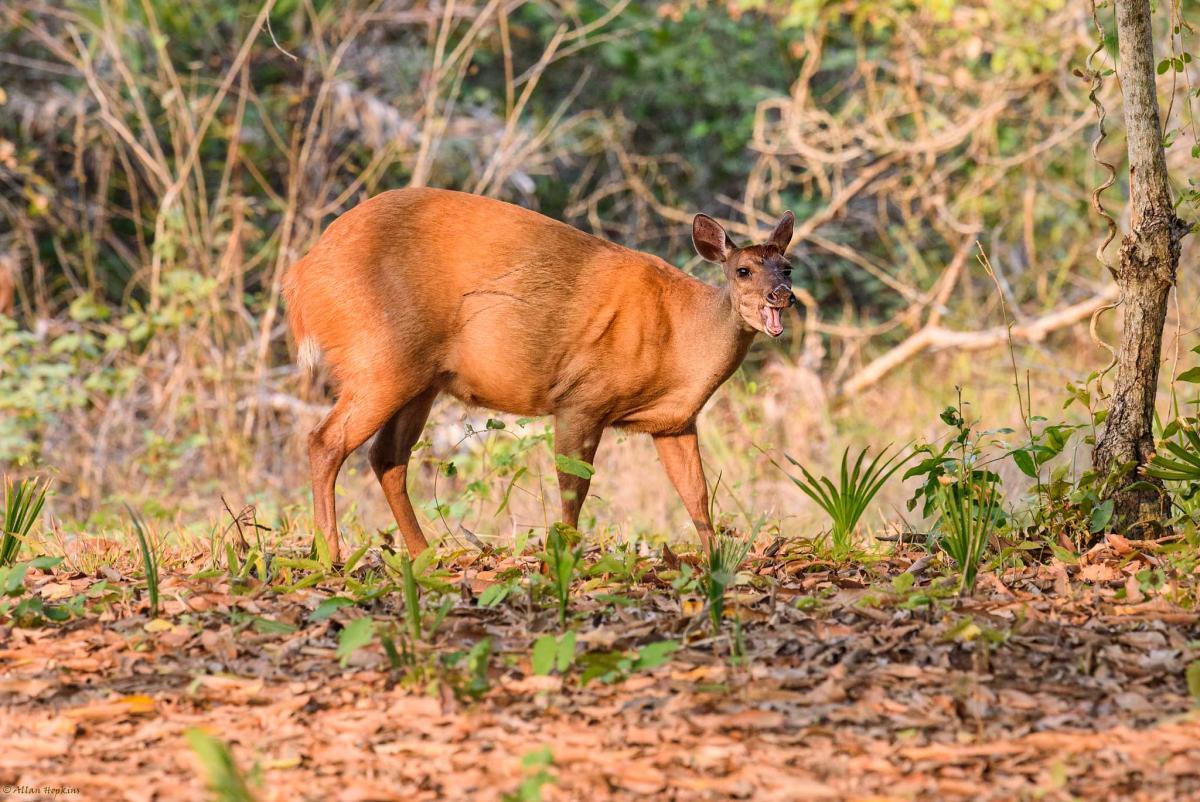
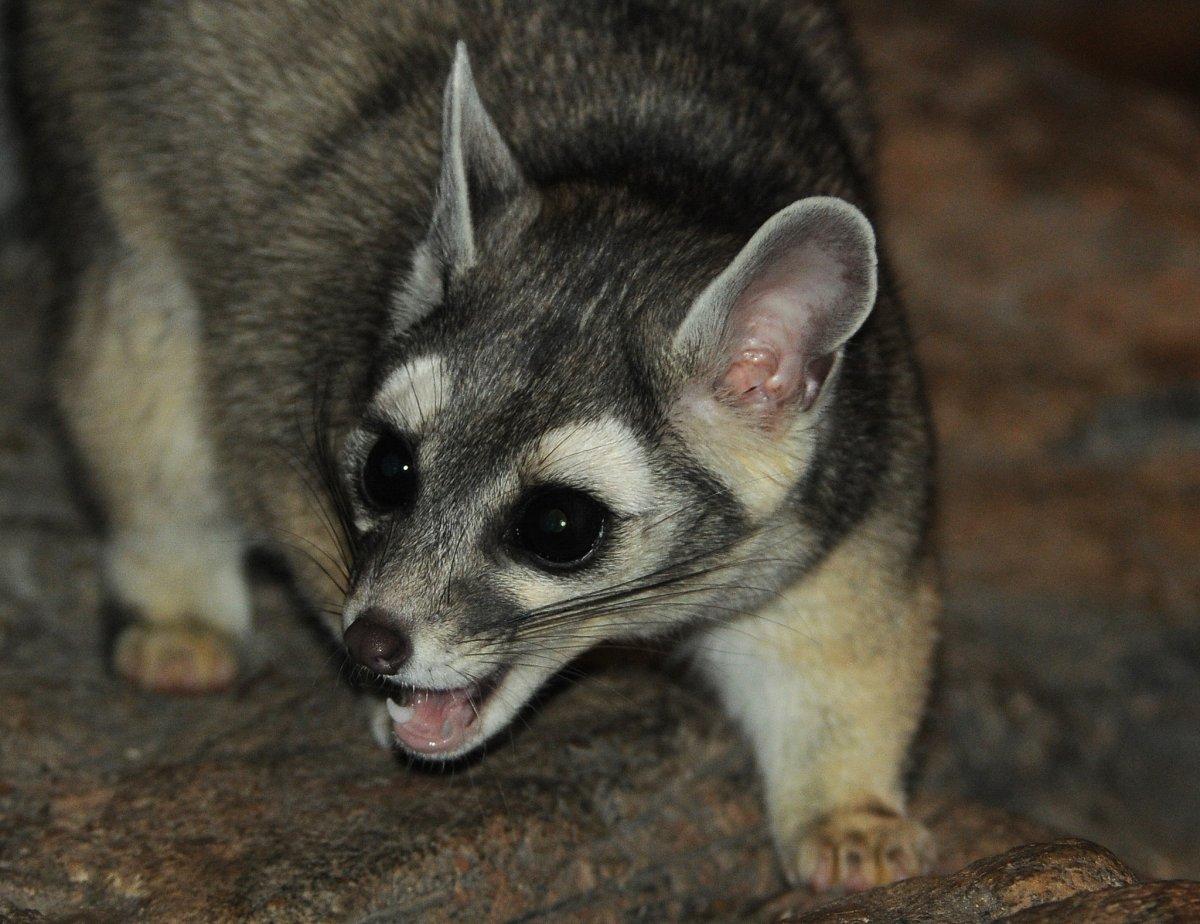
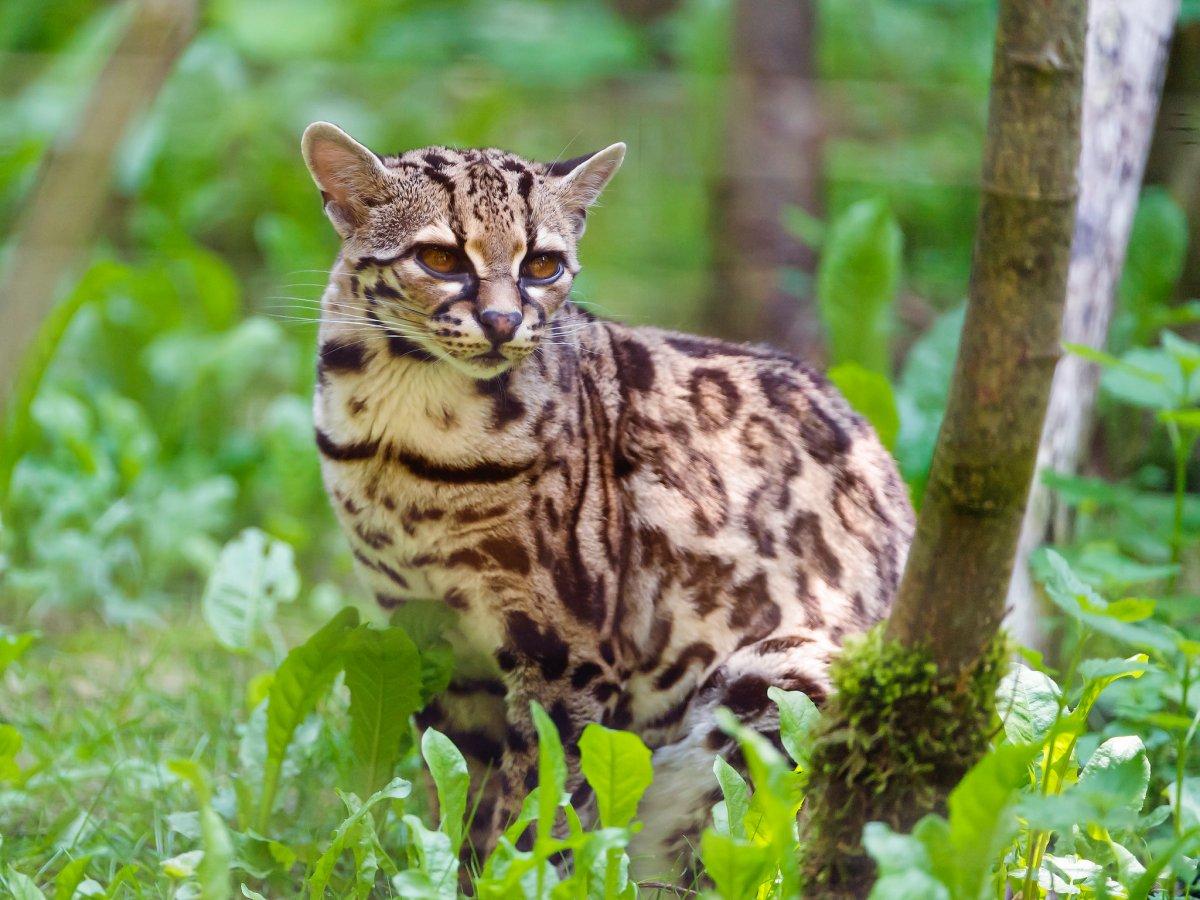
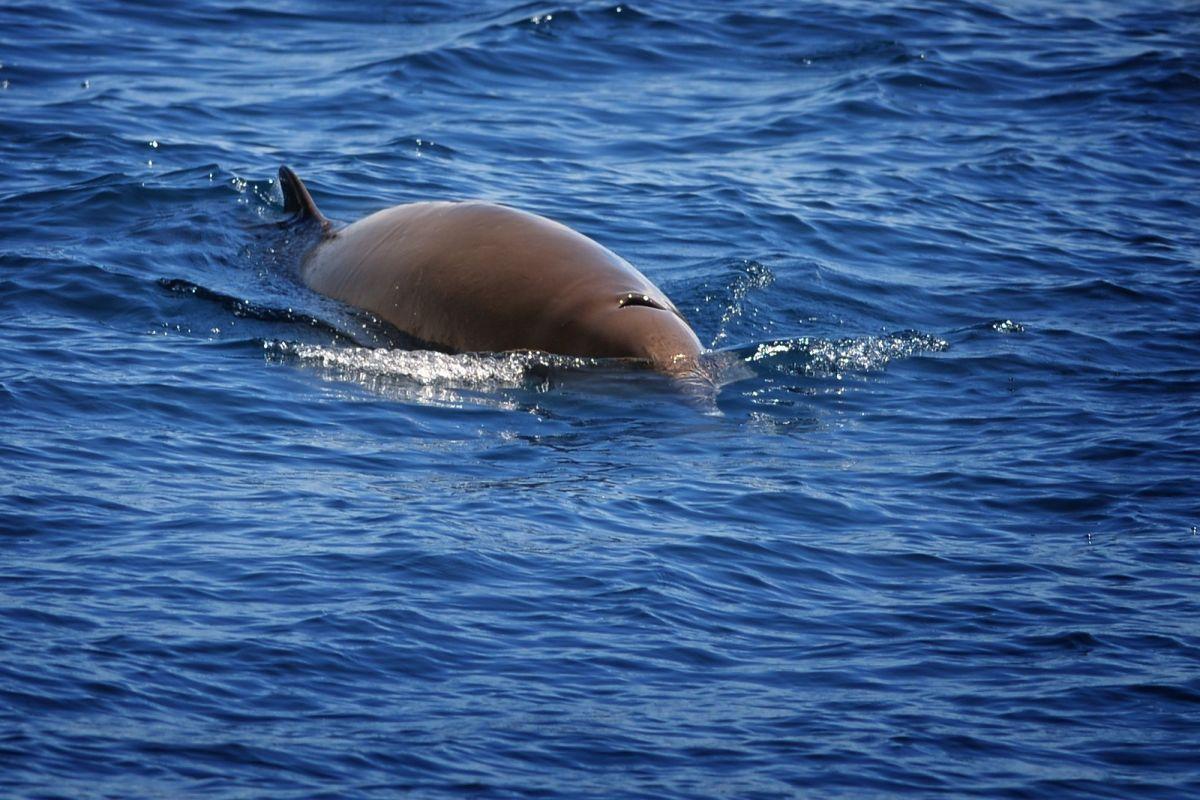
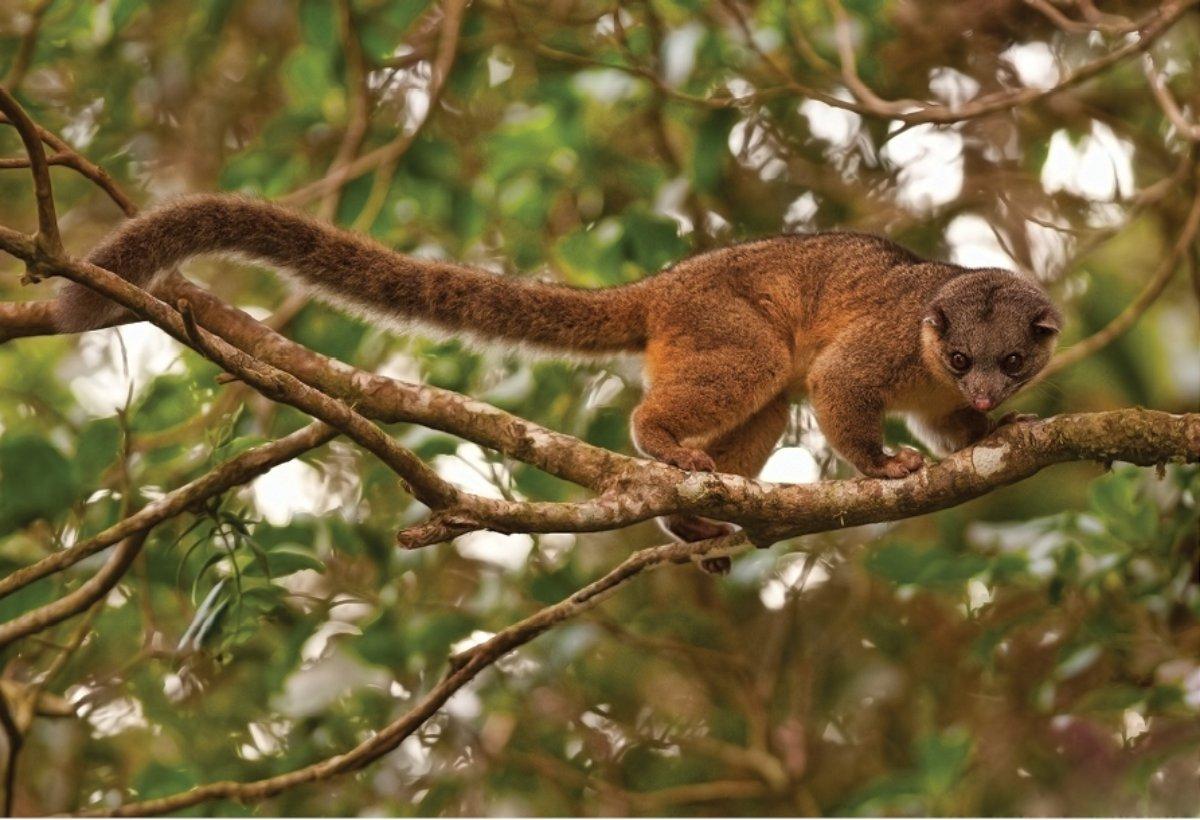
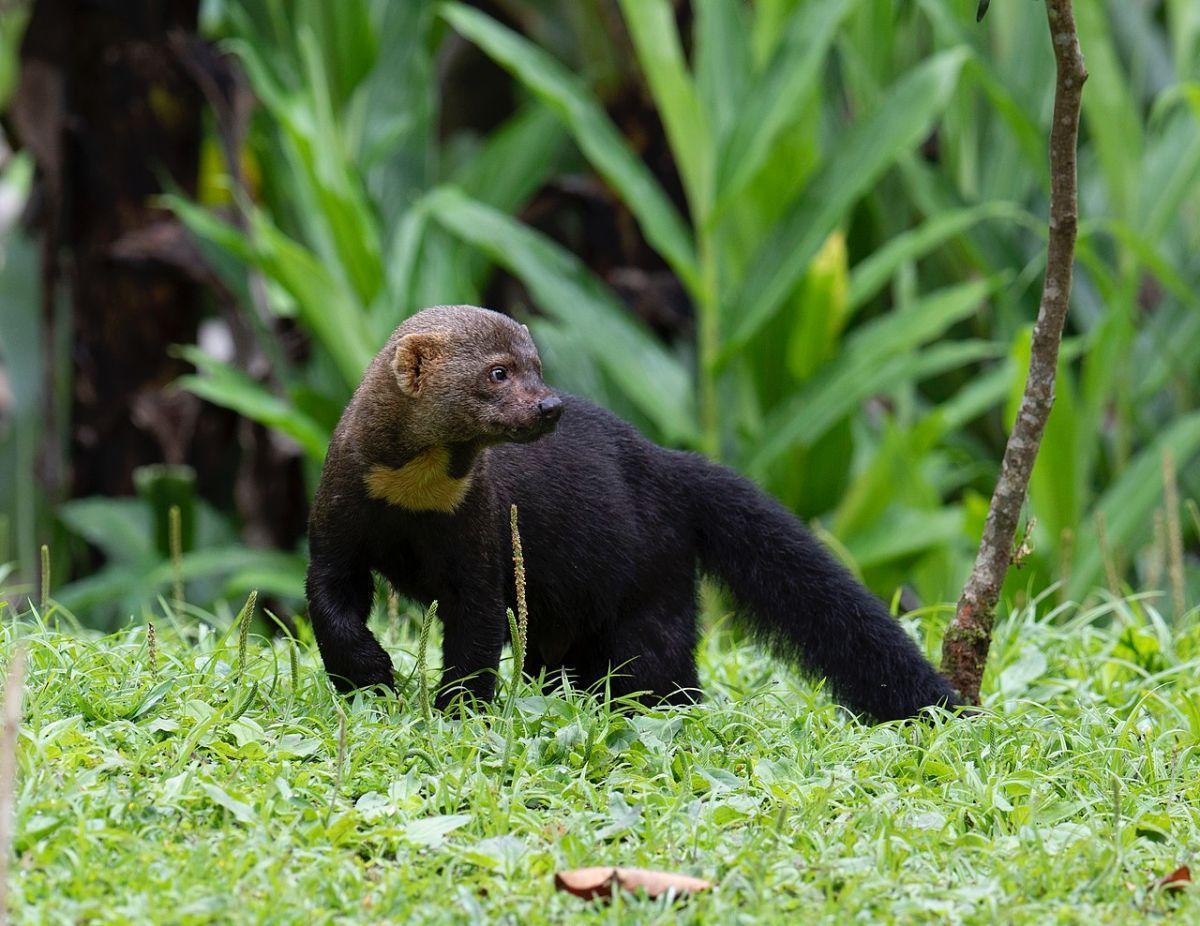
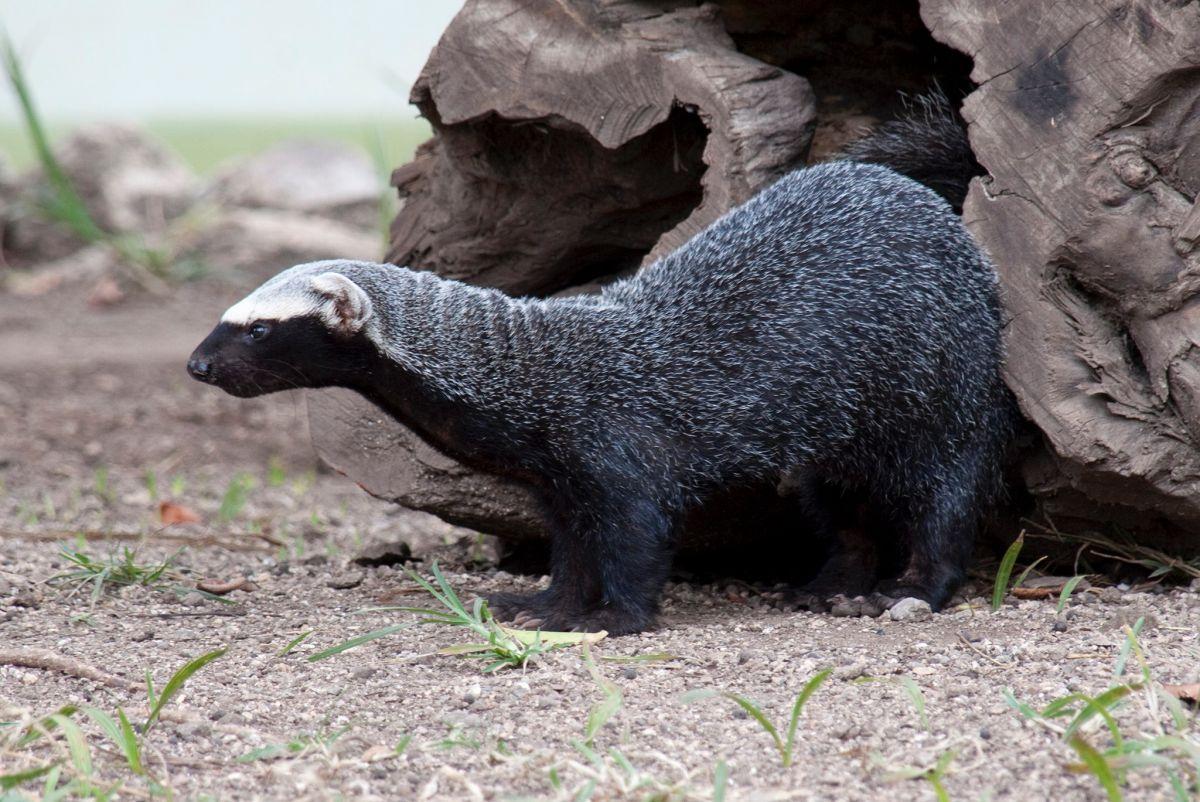

![18 Wild Animals in Congo [Wildlife in Congo]](https://www.kevmrc.com/wp-content/uploads/2022/12/18-wild-animals-in-congo.jpg)
![35 Wild Animals in China [Wildlife in China]](https://www.kevmrc.com/wp-content/uploads/2022/12/35-wild-animals-in-china.jpg)
![10 Wild Animals in Algeria [Wildlife in Algeria]](https://www.kevmrc.com/wp-content/uploads/2022/11/10-wild-animals-in-algeria.jpg)